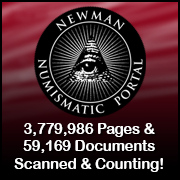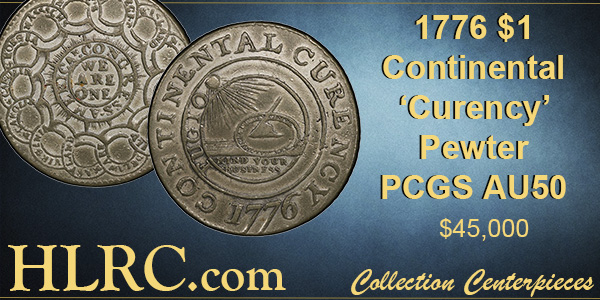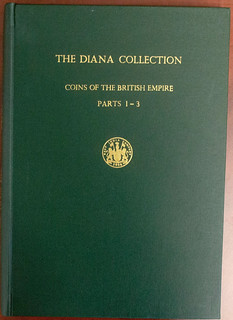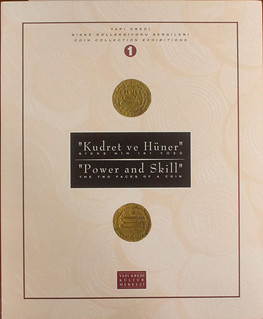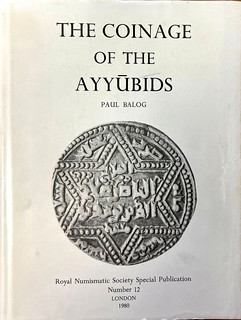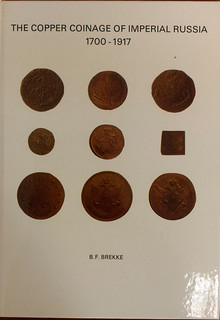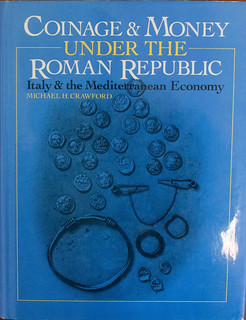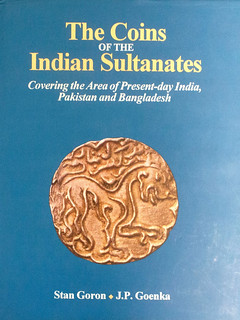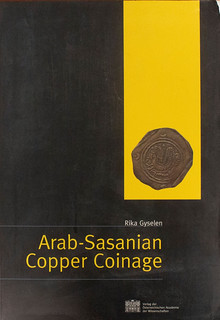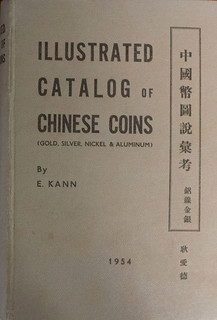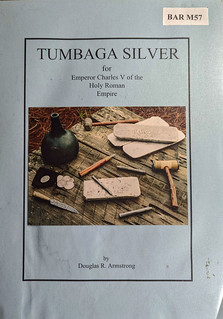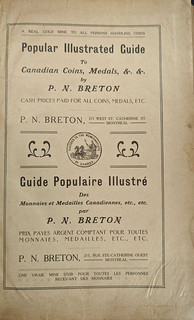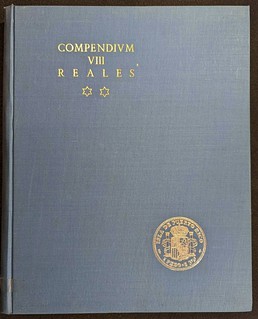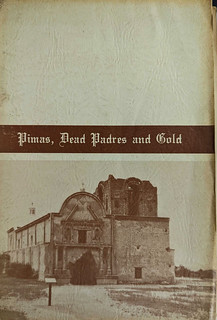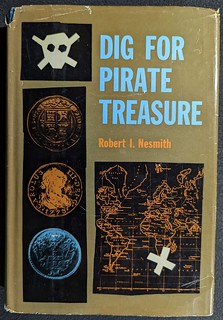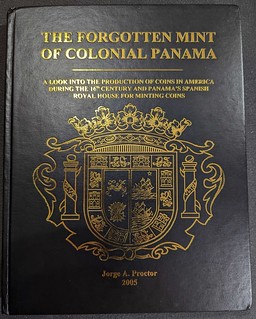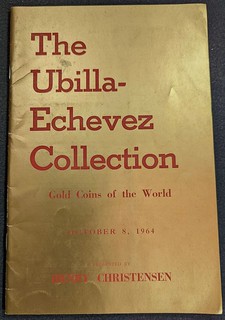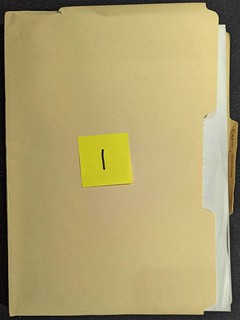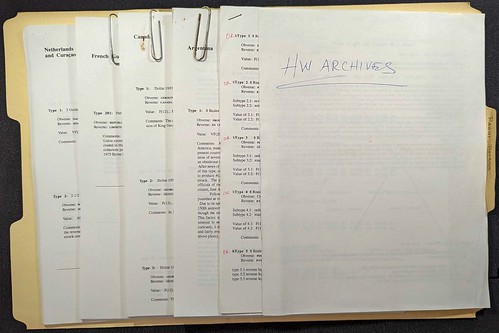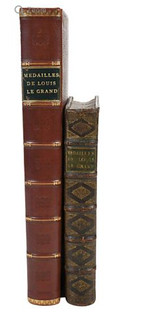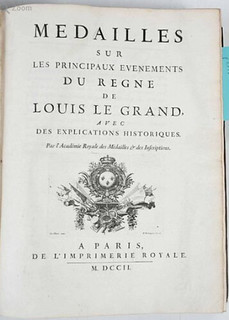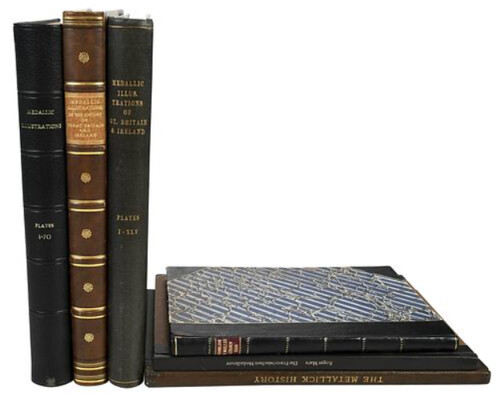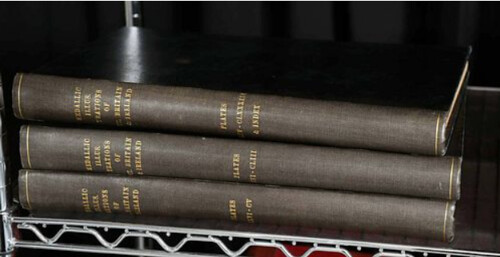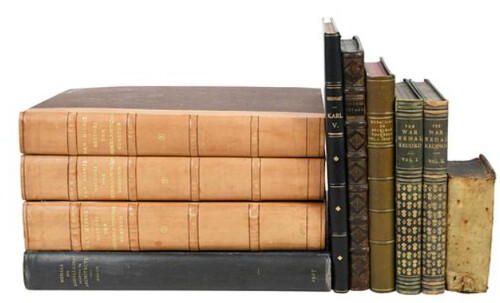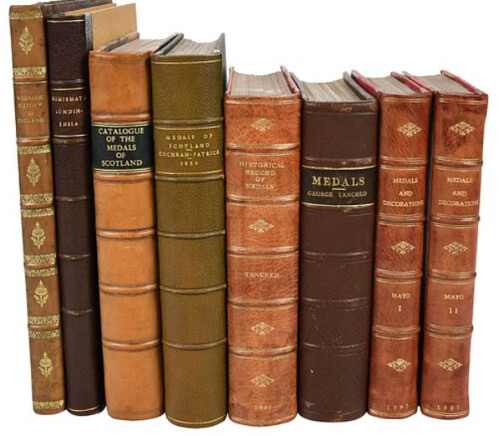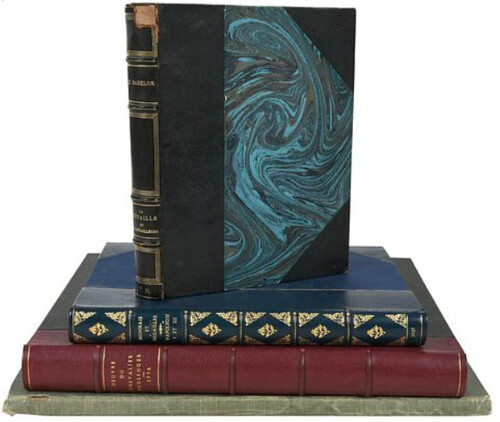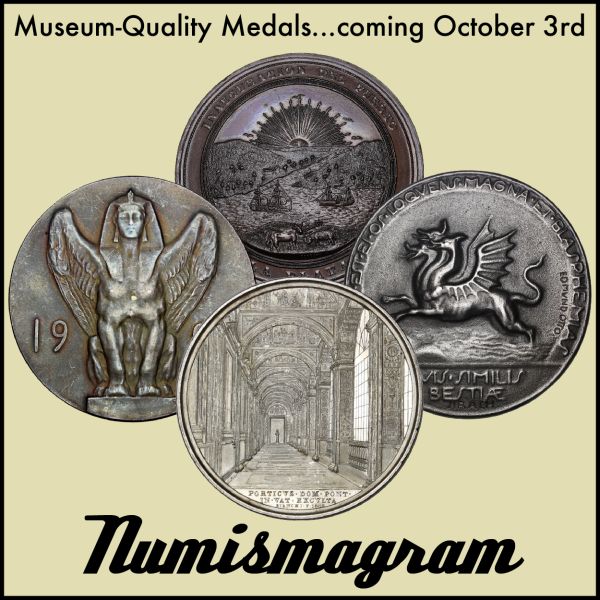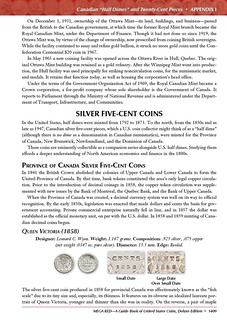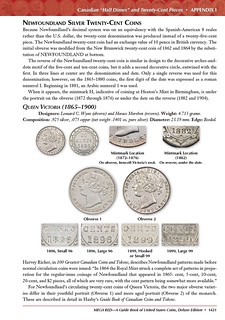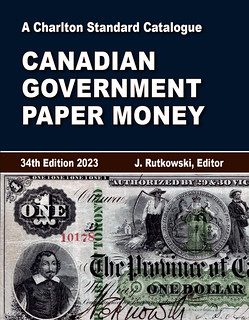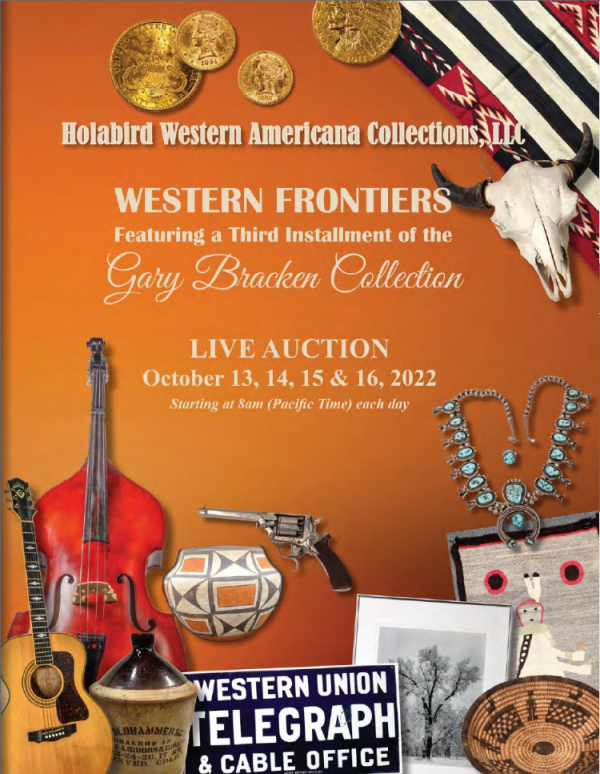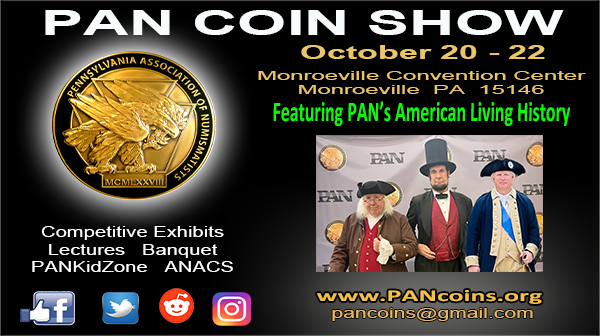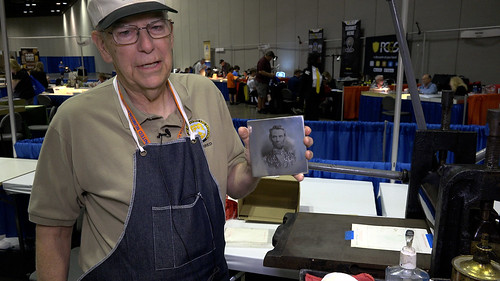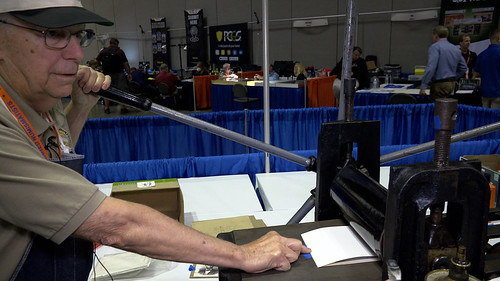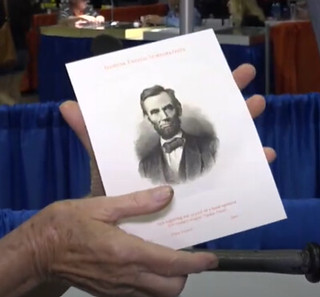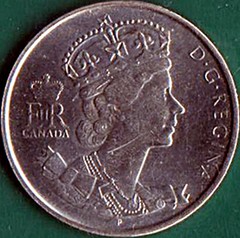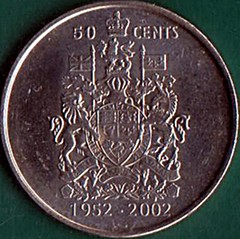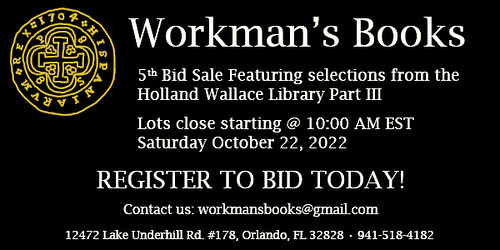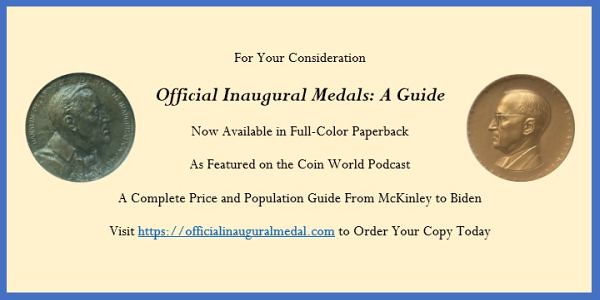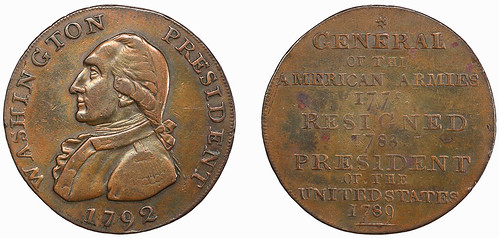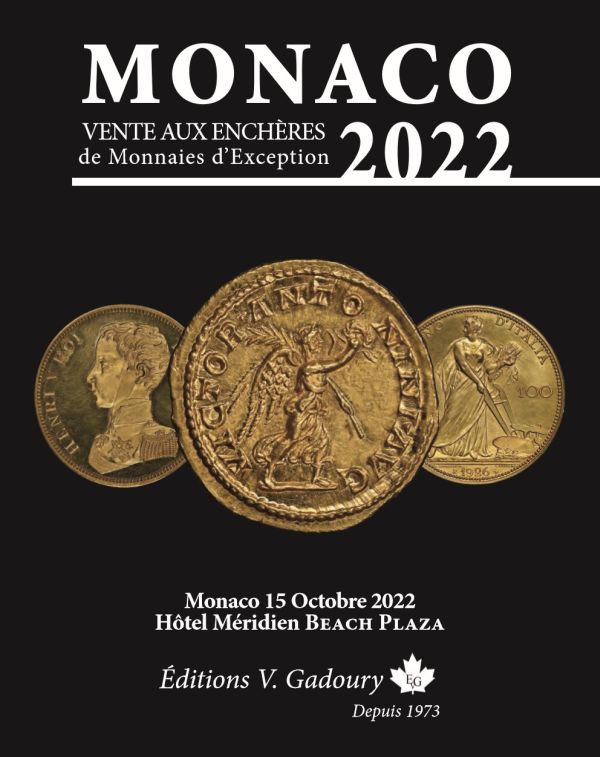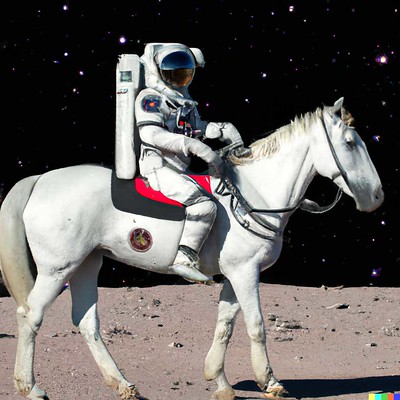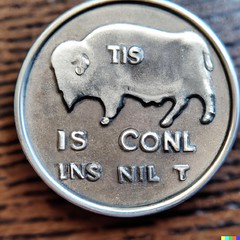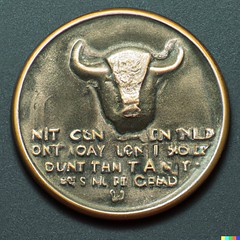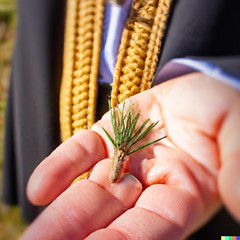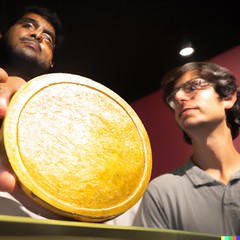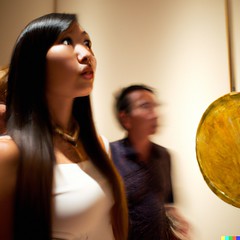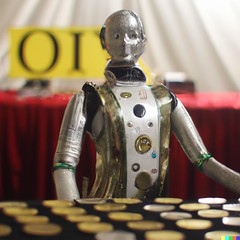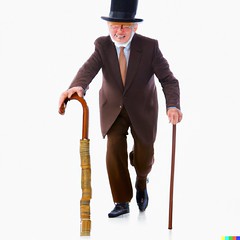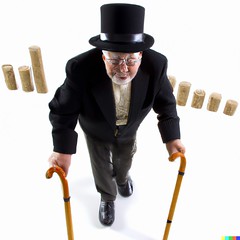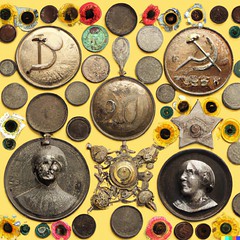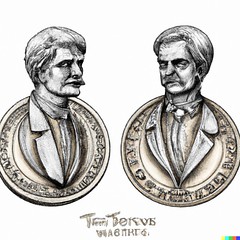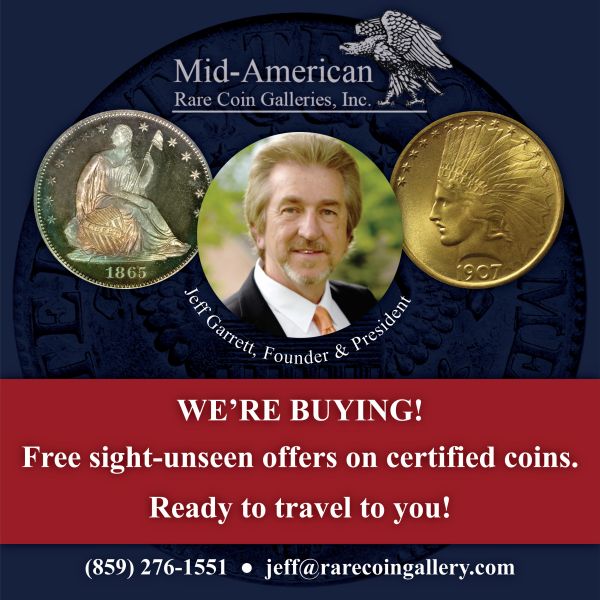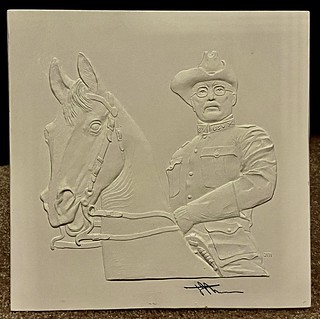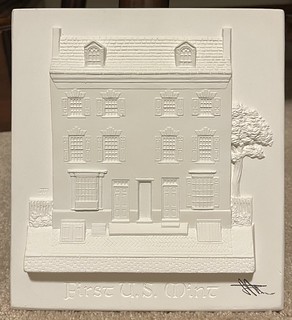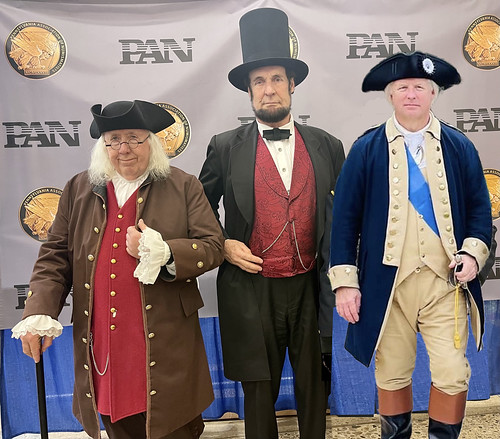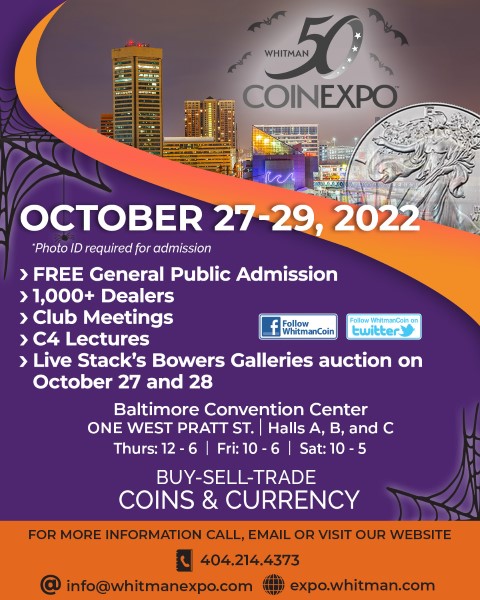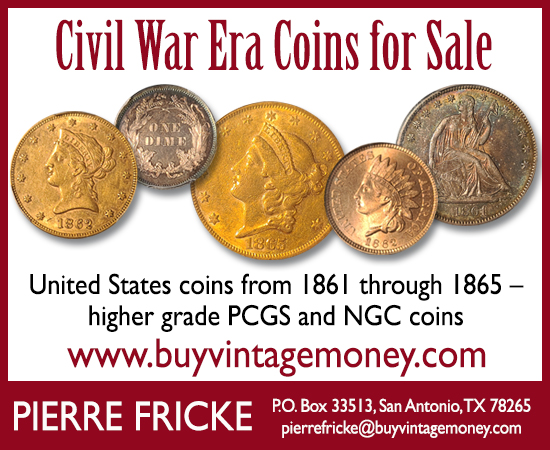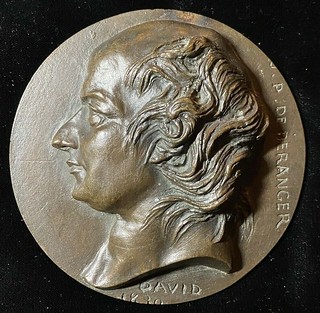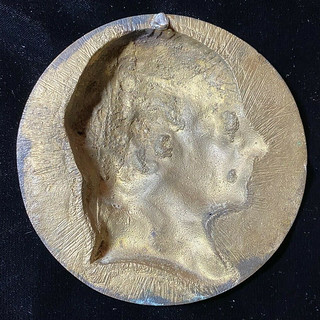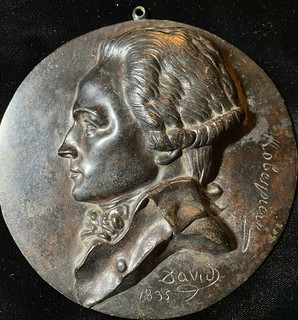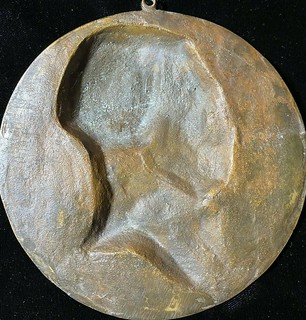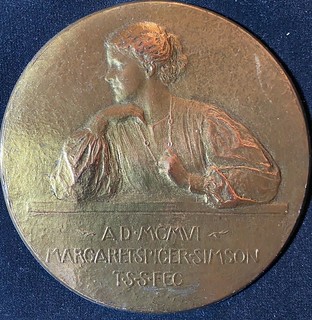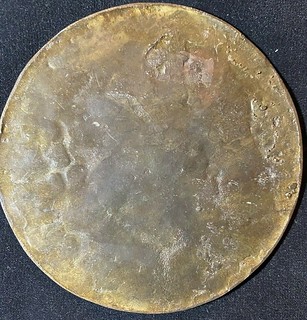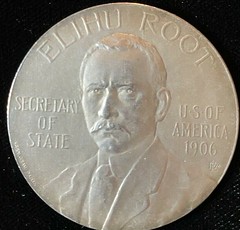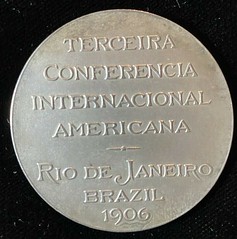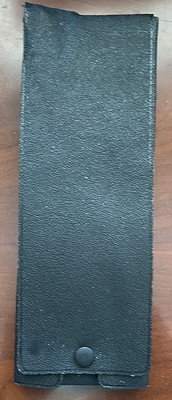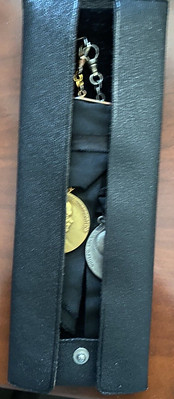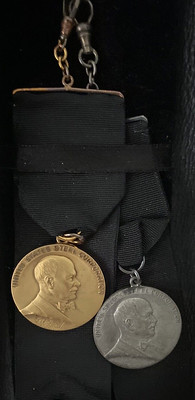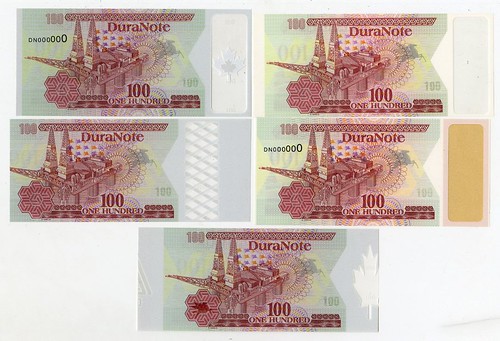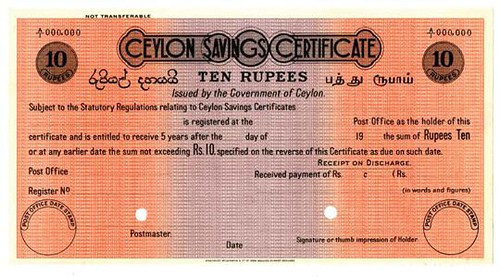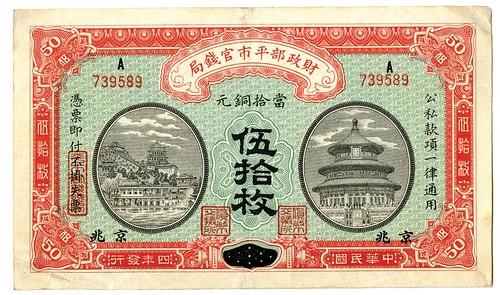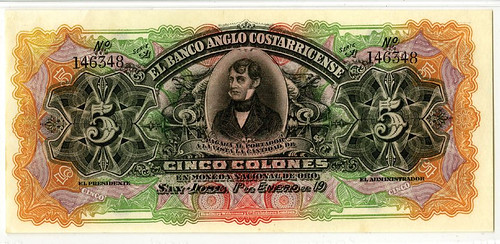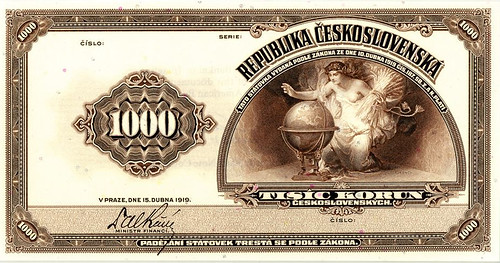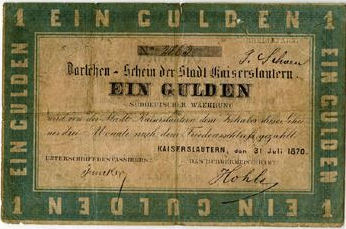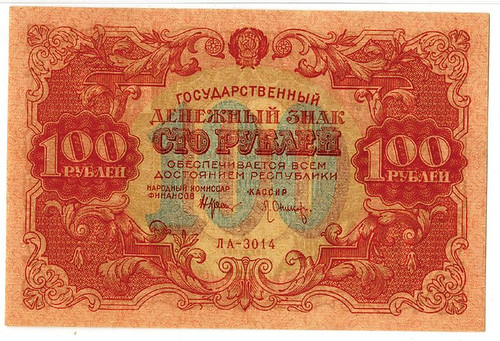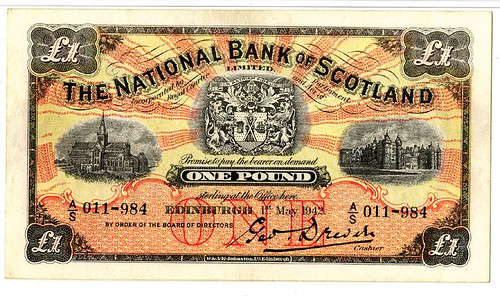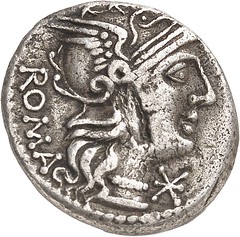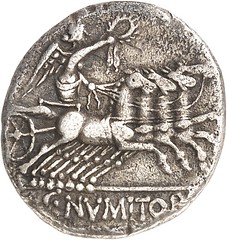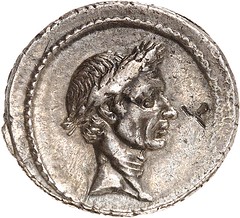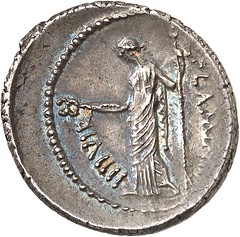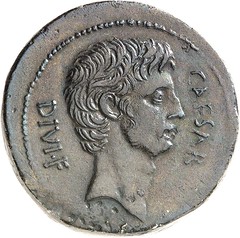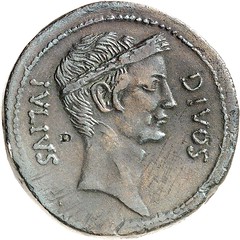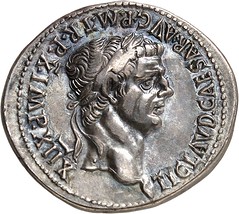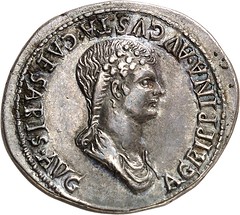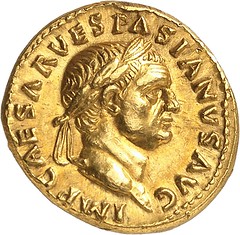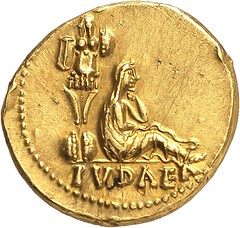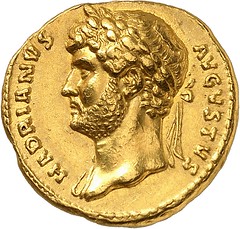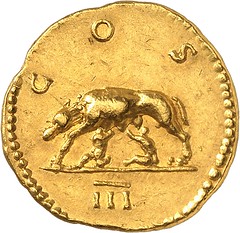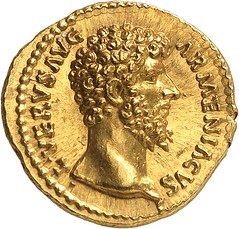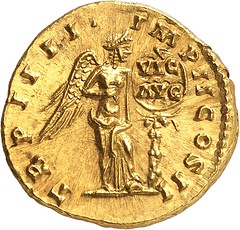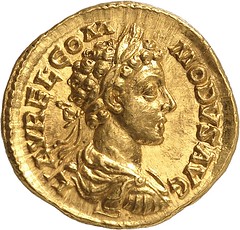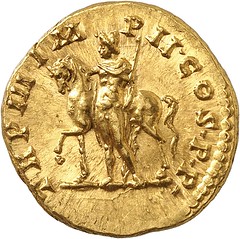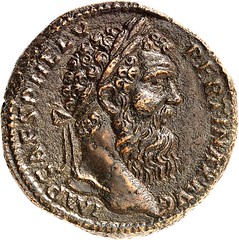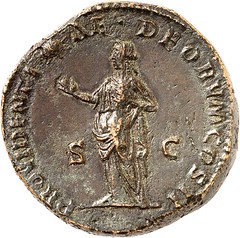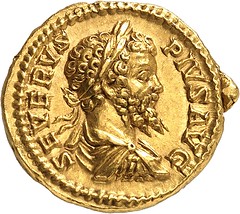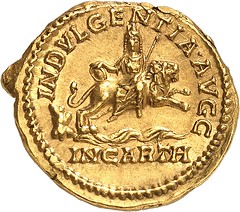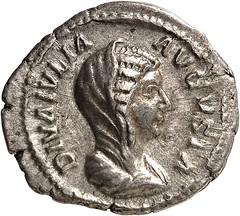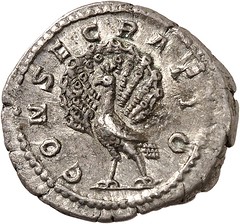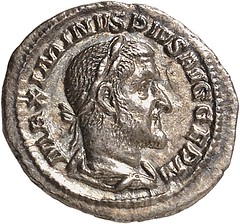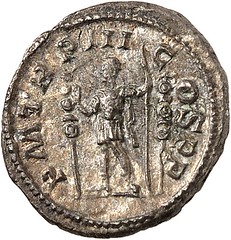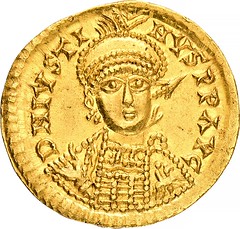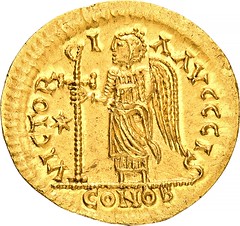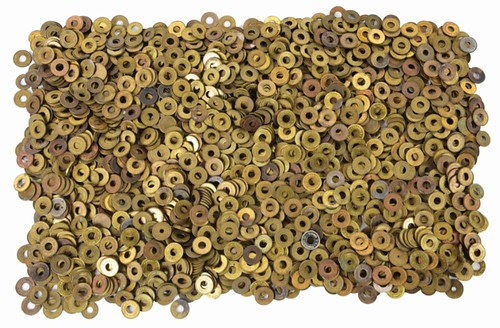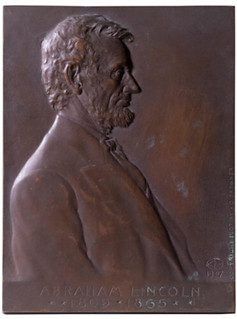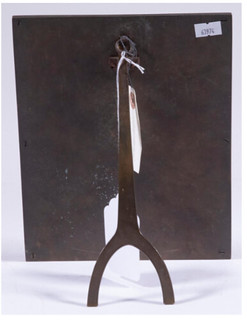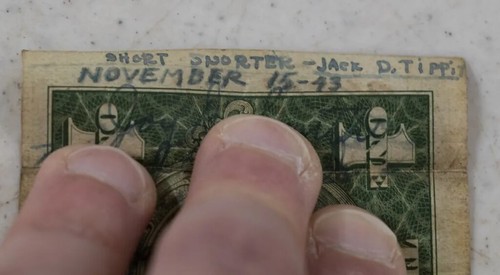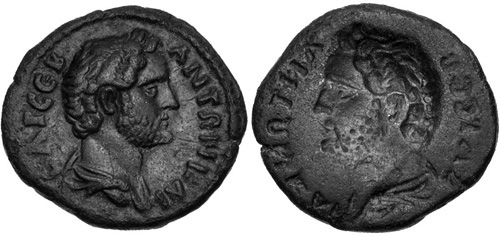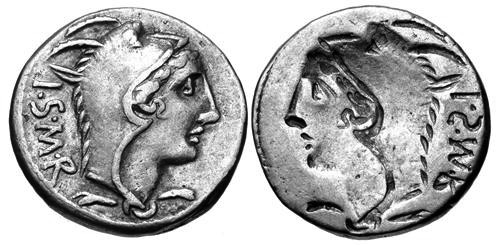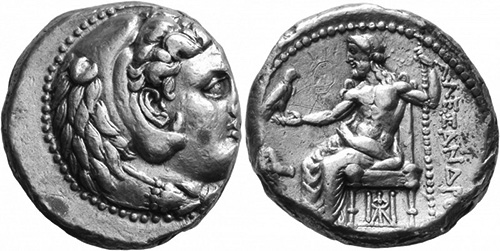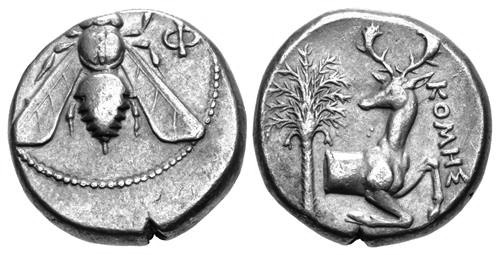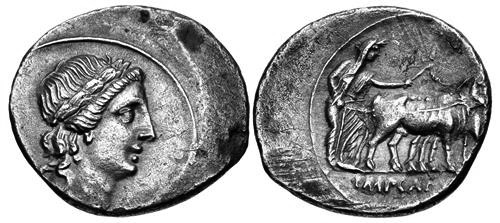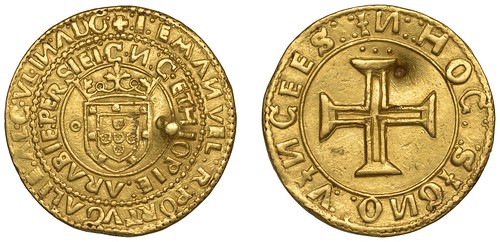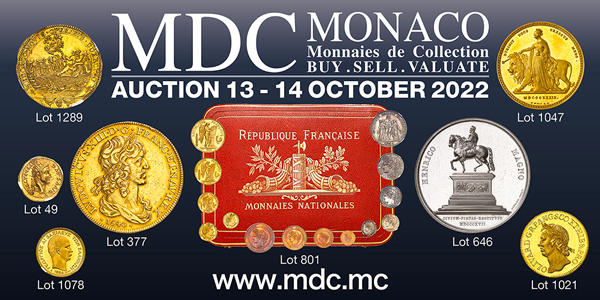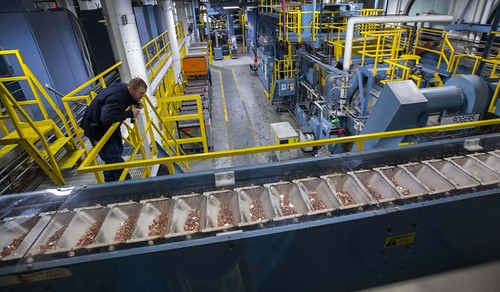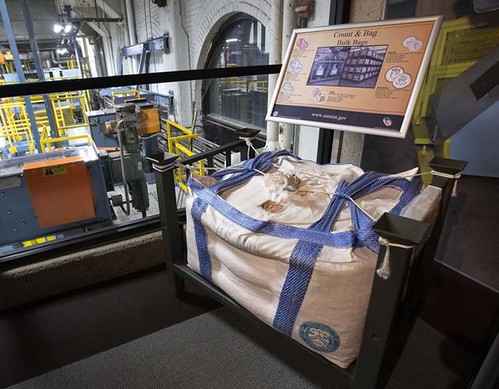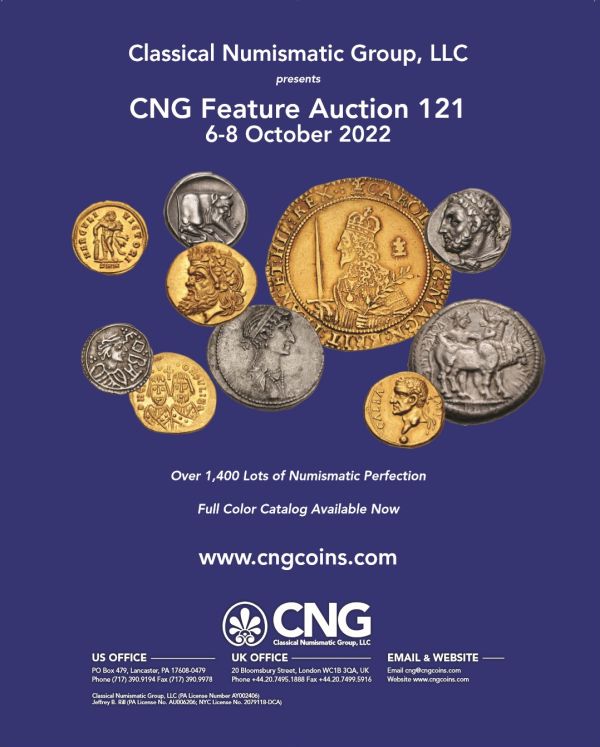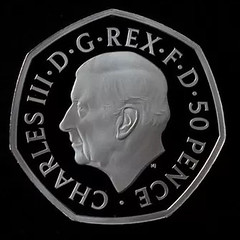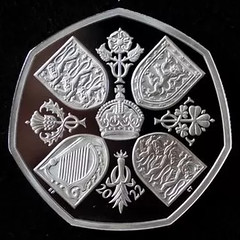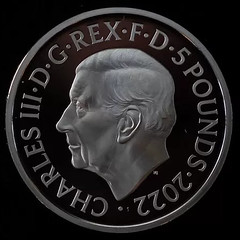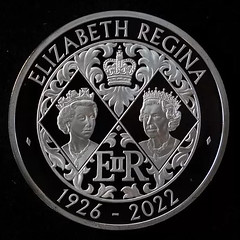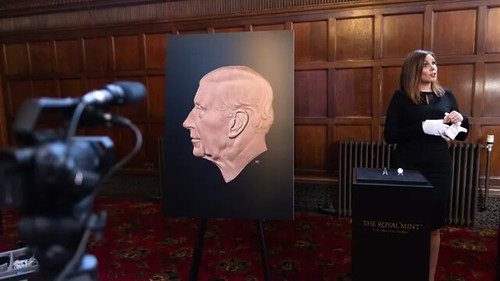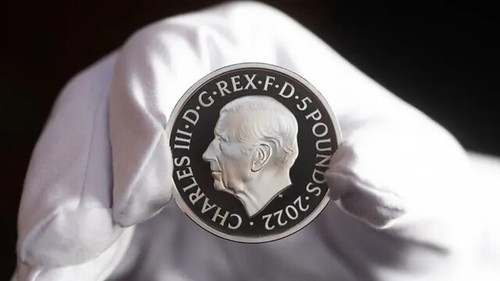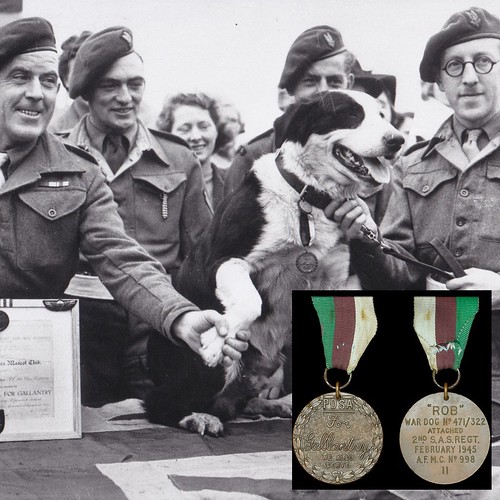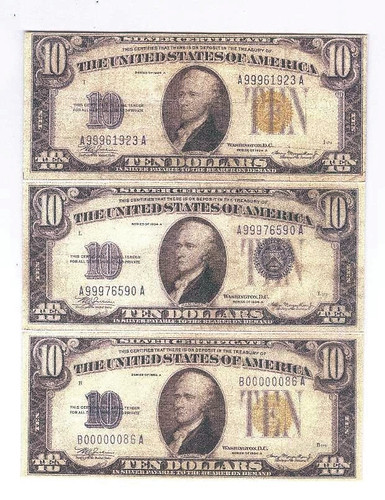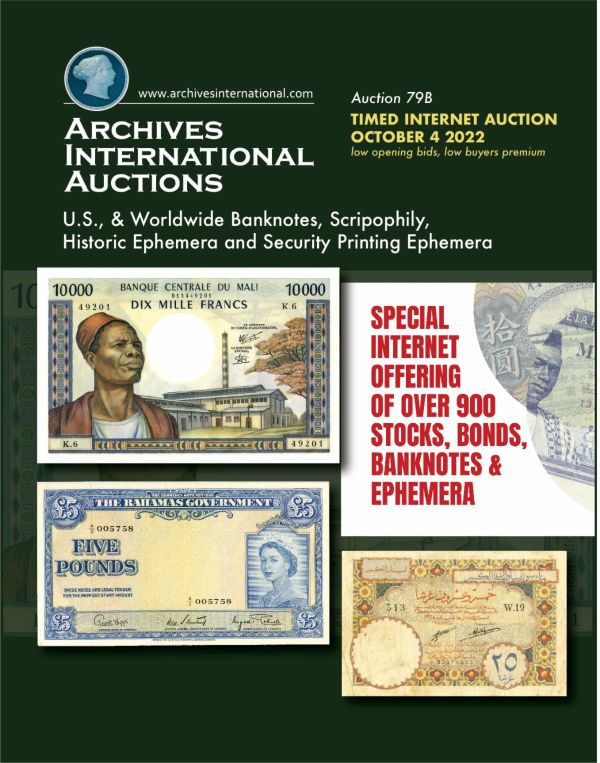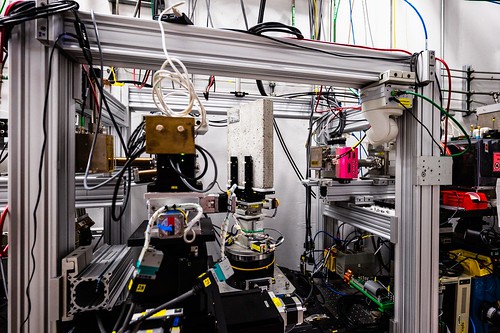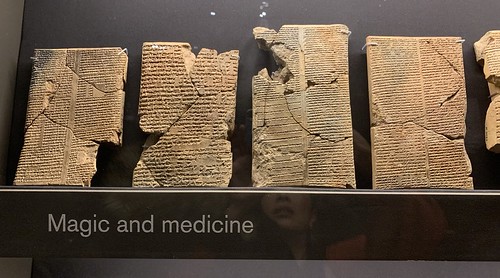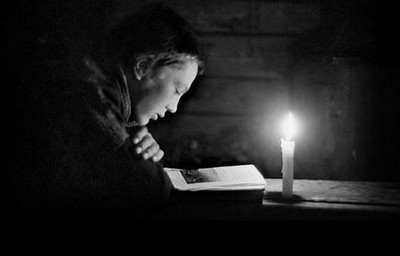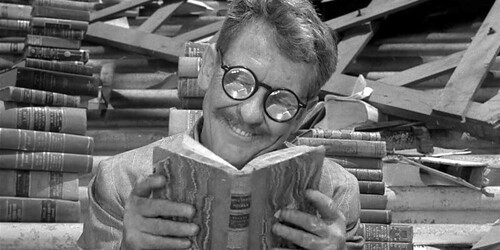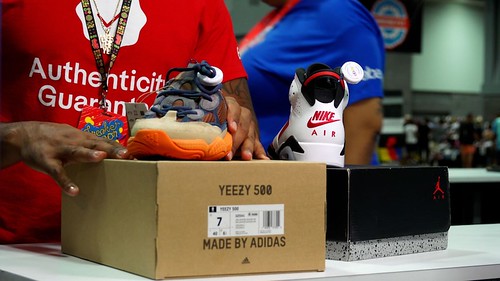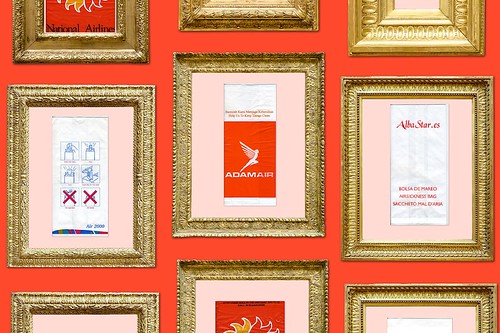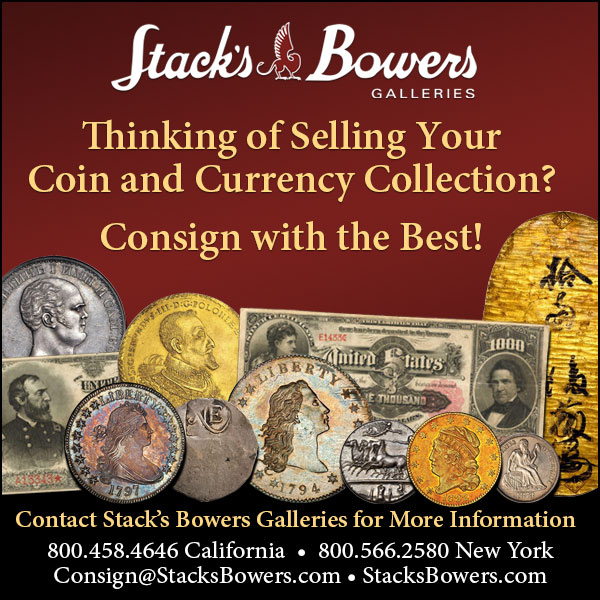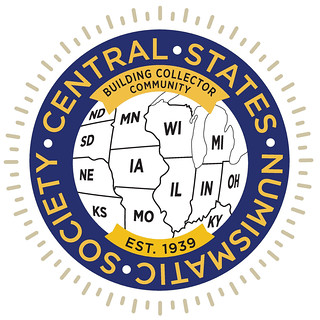
Visit our NBS Sponsors



About UsThe Numismatic Bibliomania Society is a non-profit association devoted to the study and enjoyment of numismatic literature. For more information please see our web site at coinbooks.org SubscriptionsThose wishing to become new E-Sylum subscribers (or wishing to Unsubscribe) can go to the following web page link MembershipThere is a membership application available on the web site Membership Application To join, print the application and return it with your check to the address printed on the application. Print/Digital membership is $40 to addresses in the U.S., and $60 elsewhere. A digital-only membership is available for $25. For those without web access, write to: Charles Heck, Treasurer AsylumFor Asylum mailing address changes and other membership questions, contact Chuck at this email address: treasurer@coinbooks.org SubmissionsTo submit items for publication in The E-Sylum, write to the Editor at this address: whomren@gmail.com BUY THE BOOK BEFORE THE COINSale Calendar |
- WAYNE'S WORDS: THE E-SYLUM OCTOBER 2, 2022
- STEPHEN ALBUM LITERATURE AUCTION 1
- WORKMAN'S BOOKS FIFTH BID SALE IS LIVE
- PETER H. TILLOU NUMISMATIC LITERATURE SALE
- NEW BOOK: MEGA RED 8TH EDITION ADDS CANADIAN
- NEW BOOK: 2023 CANADIAN GOVERNMENT PAPER
- NOVEMBER 2022 NNP SYMPOSIUM ANNOUNCED
- U.S COIN SCALES AND COUNTERFEIT COIN DETECTORS
- A VIRGINIA COINAGE BIBLIOMYSTERY
- VIDEO: MIKE BEAN AND THE SPIDER PRESS
- WHERE WERE ELIZABETH II CORONATION MEDALS STRUCK?
- STRIKING IMPRESSIONS PRINT RUN
- NOTES FROM E-SYLUM READERS: OCTOBER 2, 2022
- DALL-E COIN IMAGES
- OCTOBER 2022 PAN SHOW EVENTS
- VOCABULARY TERM: MAHOGANY FINISH
- JOHN/JACK ROWE, AKA JAY ROE (1924-2000)
- WEXFORD MEDAL SELECTIONS OCTOBER 2022
- ARCHIVES INTERNATIONAL AUCTION 79B SELECTIONS
- KÜNKER AUCTION SALE 377, 378 HIGHLIGHTS
- NUMISMATIC NUGGETS: OCTOBER 2, 2022
- THE ORIGINAL ERROR COINS
- RARE PORTUGUESE GOLD COIN FOUND
- WHERE THE GOVERNMENT MAKES CENTS
- KING CHARLES III COIN DESIGNS REVEALED
- ROB THE PARACHUTING DOG'S MEDALS FOR SALE
- ANOTHER ALTERED NORTH AFRICA NOTE
- U.S. $100,000 PROOF NOTE LOST IN FLOOD
- LOOSE CHANGE: OCTOBER 2, 2022
- BOOK NOOK: OCTOBER 2, 2022
- SNEAKER AUTHENTICATORS
- COLLECTING BARF BAGS
- FEATURED WEBSITE: CENTRAL STATES NUMISMATIC SOCIETY
F Click here to read the thin version on the web
Click here to subscribe
Click here to access the complete archive
To comment or submit articles, reply to whomren@gmail.com
Content presented in The E-Sylum is not necessarily researched or independently fact-checked, and views expressed do not necessarily represent those of the Numismatic Bibliomania Society.
WAYNE'S WORDS: THE E-SYLUM OCTOBER 2, 2022
Thank you for reading The E-Sylum. If you enjoy it, please send me the email addresses of friends you think may enjoy it as well and I'll send them a subscription. Contact me at whomren@gmail.com anytime regarding your subscription, or questions, comments or suggestions about our content.
This week we open with three numismatic literature sales, two new books, updates from the Newman Numismatic Portal, notes from readers, and more.
Other topics this week include coin scales, the spider press, Striking Impressions, the fall PAN Show, Jay Roe, fixed price and auction selections, ancient error coins, King Charles III coin designs, the ultimate Dickin Medal, and altered North Africa notes.
To learn more about Copper Coinage of Imperial Russia, the Forgotten Mint of Colonial Panama, Mega Red, the NNP Symposium, tipping with twos, DALL-E coin images, John Mercanti plaster sculpts, sculptor David D'Angers, U.S. Steel service medals, the 1907 Brenner Lincoln plaque, the Denver Mint, Rob the Parachuting Dog, numismatic losses due to weather events, milling and engraving machines, collectomania and Death by Banknote, read on. Have a great week, everyone!
Wayne Homren
Editor, The E-Sylum
STEPHEN ALBUM LITERATURE AUCTION 1
Stephen Album Rare Coins is holding their first numismatic literature auction on October 17, 2022. Here are some lot selections. -Editor
Lot 5: A. H. Baldwin & Sons Ltd., The Diana Collection: Coins of the British Empire, Parts 1-3, London, 2008-09, all three auction catalogs of the Diana Collection hardcover bound together with prices realized.
Lot 14: Aydin, Sennur, Kudret ve Huner: Sikke'nin iki Yuzu / Power and Skill: The Two Faces of a Coin, Yapi Kredi Bank, Istanbul, 1994, 55 pages, softcover large format. The first of the series of catalogues of exhibitions of the bank's coin collection. It includes a general history of the origin of Islamic coinage, then covers Arab-Byzantine, Arab-Sasanian, Umayyad, Umayyad of Spain, Abbasid, Tulunid, Fatimid, Ayyubid, Mamluk, Idrisid, Aghlabid, Tahirid, Saffarid, Banijurid, Sajid, Wajjahid (Oman), Samanid, Ikhshidid, Buwayhid, Marwanid, Rassid (2nd period), Rasulid, Shirvanshah. Beautiful color photos. Bilingual (Turkish and English).
Lot 17:Balog, Paul, The Coinage of the Ayyubids, Royal Numismatic Society, Hertford, 1980, 334 pages, 50 plates, hardcover with dust jacket. The book covers the medieval Islamic coinage of Saladin and his successors in the Fertile Crescent and Arabia: Egypt, Syria, Mesopotamia and Yemen. Includes an index of years and mints. The definitive work on Ayyubid coinage, ex Libris Norman D. Nicol. Norman D. Nicol edited this book for Balog and constructed the plates.
Lot 28: Brekke, B. F., The Copper Coinage of Imperial Russia, 1700-1917 Malmö, 1977, 296 pages, illustrated throughout with photographs of coins, hardcover, English text. An important reference work on Russian coins. With supplement by Russian Numismatic Society, Akron, Ohio, 1987. A compilation of new types and dates discovered in the decade since his original book. There is a valuation guide compiled by James Elmen to be used in conjunction with the main volume. Still one of the best books on Russian copper.
Lot 44: Crawford, Michael H., Coinage and Money Under the Roman Republic: Italy and the Mediterranean Economy, London 1985, 355 pages, hardcover with dust jacket. Great reference book for collectors of Roman Republic coinage.
Lot 70: Goron, Stan & Goenka, J.P. Coins of the Indian Sultanates Munshiram Manoharlal Publishers Pvt. Ltd., New Delhi, 2001, 564 pages with photos throughout, hardcover with dust jacket. An extensive and incredibly well-produced catalouge of the Arab Governors of Sind, Amirs of Sind, Amirs of Multan, Ghaznavids, Sultans of Dehli, Sultans of Bengal, Madura, Bahmani Sultans and their precursors, 'Adil Shahs of Bijapur, Barid Shahs of Bidar, Nizam Shahs of Ahmadnagar, Qutb Shahs of Golkonda, Sultans of Jaunpur, Kalpi, Gujarat, Khandesh, Kashmir, Sind and the Punjab. There is good introductory information, each type is photographed, and the legends are described. Legends are written out in Arabic in the coin descriptions, but can generally be found elsewhere. Printed on good heavy paper. A wonderful production that generally makes Rajgor's catalogue obsolete.
Lot 75: Gyselen, Rika, Arab-Sasanian Copper Coinage Verlag der Oesterreichischen Akademie der Wissenschaften, Vienna, 2000, 208 pages, 15 plates, softcover. An exhaustive study of Arab-Sasanian coppers. The introductory material covers the monetary prototypes, the iconography of the coins (busts, fire altar, animals, symbols), letends, dates, and various religious formulae. More than 100 types are illustrated with good line drawings and very detailed descriptions. Finally, there are many indices of legends in different scripts, collections, finds, and, at the end, photographic plates, ex James Farr Collection Library.
Lot 94: Kann, Eduard, Illustrated Catalog of Chinese Coins Los Angeles, 1954, original printing, 476 pages, 224 plates, hardcover with dust jacket in good condition. Long-time standard in-depth work on gold, silver, nickel. More historical information and depth of varieties than Krause. Still a much quoted reference work and a must for the collector of struck Chinese coinage, ex Dr. Allan Pacela Numismatic Library.
To view the lot descriptions or bid, see:
Stephen Album Rare Coins | Literature Auction 1
(https://www.sarc.auction/Stephen-Album-Rare-Coins-Literature-Auction-1_as84908)
WORKMAN'S BOOKS FIFTH BID SALE IS LIVE
Alan Workman's latest sale is open for lot viewing and bidding. -Editor
Workman's Books announces its fifth bid sale is LIVE!
Workman's Books is conducting its Fifth sale and Part III of Selections from the library of long-time dealer, collector, and author, Holland Wallace. The sale will close at 10:00 AM on October 22, 2022 and will include 622 lots of rare, vintage, and out-of-print numismatic books, auction sale catalogs, dealer fixed price lists, and numismatic journals with subject matter focusing on the United States, Canada, Mexico, Central & South America, Europe, Portugal, Spain, Spanish colonial, Islamic, and Asain numismatics. The selections for this sale include important works and sales by Album, Bailey, Breton, Bruns, Burzio, Calbeto, Calico, Cayon, Chapman, Christie's, Christensen, Douglas, Elder, Ferrari, Gadoury, Glendining, Grove, Leroux, Low, Medina, Ponterio, Pradeau, Pridmore, Prober, Schulman, Sellschopp, Sotheby's, Stack's, Superior, and many others. Accompanying the Wallace library is a sizeable consignment of books, catalogs, magazines, maps, and ephemera on shipwrecks, sunken treasure, lost treasure, treasure hunting, lost mines, and treasure in the American West.
This bid sale is being held through the online venue iCollector, and all registrations, approvals, and bids will be handled there. For this bid sale the lots will be closing on a timed interval with extensions of 1 minute for any bids placed within 1 minute of closing. If you already have an iCollector account, you still must "GET APPROVED" to bid for each sale by entering and confirming your information for this bid sale, like reviewing your shipping information and choosing your preferred way of payment. Remember, tie bids go to the earliest bidders, so don't wait for the lots to close to bid on anything for which you have a strict number in mind.
Now is the perfect time to register for the bid sale, as any registration issues can certainly be accommodated more easily in advance. Do not wait to register the last day. Registration and bidding online are always FREE (no extra fees or percentages for bidding online). Once you are registered and automatically approved, first be sure to bookmark the items that interest you.
Sale Order:
Session 1: (Lots 1 to 622)
- Books: Lots 1-329
- Auction Catalogs & FPLs: Lots 330-527
- Numismatic Journals: Lots 528-591
- Magazines: Lots 592-610
- Maps: Lots 611-619
- Shipwreck Memorabilia: Lot 620
- Newspapers: Lot 621
- Original Manuscripts: Lot 622
Session 1: Some Featured Items
Lot 11 Armstrong: Tumbaga Silver for Emperor Charles V of the Holy Roman Empire
Armstrong, Douglas R. TUMBAGA SILVER FOR EMPEROR CHARLES V OF THE HOLY ROMAN EMPIRE. Douglas R. Armstrong. 1993. 4to. iv, 40, (10), 41, (3) pages. Palm Bay. original plastic and card covers, some water damage to back few pages. illustrated. tables. Very Good. signed by author and treasure coin dealer, Dan Sedwick. booklet for bar M57. The study of a large trove of early 16th Century Spanish silver bars recovered from a shipwreck off Grand Bahama Island. Lot weight: 0 lbs 11oz. Subject(s): Sunken Treasure.
Lot 32 Breton: Two Classic Works on Canadian Coins and Medals
Breton, P.N. TWO CLASSIC WORKS ON CANADIAN COINS AND MEDALS BY BRETON. P.N. Breton. 1894,1912. 8vo. pages. The two works by Breton in this lot include
(1) Montreal. later green cloth, gilt, original paper covers bound in. covers chipped. 239, (1) pages. text line illustrations and tissue-guarded portrait plates. Fine. This book is a general book on Canadian numismatics and presents the history, rarity, and an approximate value of each coin and medal. It includes many pages of coin and medal illustrations and portrait photos. Clain-Stefanelli #8517.
(2) Montreal. later green cloth, gilt. 195, (1) pages. text line illustrations and portraits. Fine. This book is a general book on Canadian numismatics and presents text line illustrations and an approximate commercial value of each coin and medal. It includes many pages of coin and medal illustrations and an annexed table at the end giving the prices paid by Breton. Clain-Stefanelli #8518. Lot weight: 3 lbs 2oz. Subject(s): Canadian Coinage and Medals.
Lot 43 Calbeto de Grau: Compendio de las Piezas de Ocho Reales
Calbeto de Grau, Gabriel. COMPENDIO DE LAS PIEZAS DE OCHO REALES. Juan Ponce De Leon. 1970. fo. (2), 733, (1) pages. San Juan. Two volumes. matching original blue cloth, gilt. numerous b&w text plates. Fine. English and Spanish text. A comprehensive study of the Eight Reales of Spain, Mexico, Central America, and South America, an index of the rulers of the time period, and a listing of mints in alphabetical order. It catalogs virtually every eight real coin ever minted and is richly illustrated with hundreds of photographs. It is regarded by many as the definitive guide to eight reales. Clain-Stefanelli #11323. ex Douglas Armstrong Library. Lot weight: 9 lbs 15oz. Subject(s): Latin American Coinage.
Lot 139 Lease: Pimas, Dead Padres and Gold. Intrigue, Death and Lost Riches in the Pima Uprising of 1751
Lease, Paul V. PIMAS, DEAD PADRES AND GOLD. INTRIGUE, DEATH AND LOST RICHES IN THE PIMA UPRISING OF 1751. A TREASURE HUNTER'S VERSION AS SEEN THROUGH HIS JOURNAL. Archivist's Press. 1965. 12mo. (2), viii, 61, (3) pages. Menlo Park. first edition. later black cloth, original pictorial card covers laid in. copy of original folded map laid in. Very Good. Limited printing of 1000 copies. This book is a scarce work on the legendary lost treasure from the Pima Uprising of 1751. Chapters include Introductory, The Journal of Paul V. Lease, The Golden Windfall, Tomb for a Dead Padres, etc. There are black and white sketches of Caborca and Tubutama. The mission on the front cover is Tumacacori, one of the missions attacked during the harassment of the Santa Cruz Valley. Karl von Mueller noted (The Journals of El Dorado (1977)): 'Though not actually written by Lease, this book is a compilation of his notes and journals concerning a vast treasure hidden in southern Arizona by the Mexicans during the Pima uprising of 1751. Lease died before completing the project.'
'What my husband began as research in his youth and developed into a hobby in his middle age had become an obsession in his later years. Years that were made miserable by a deluge of letters and phone calls seeking the information he had spent forty years gathering. Upon his death in 1963, I determined to end this senseless barrage of communication by publishing his journal. I have destroyed all of Paul's papers together with the notes and manuscript. They are ashes now and the only information remaining is contained in this, the final manuscript. To those scores of persons, who seem determined to follow in Paul's footsteps, I have only pity and were not my own peace of mind and personal safety concerned, I would have destroyed this manuscript also.' - Mrs. P.V. Lease
Seldom offered for sale in any condition. Very scarce. Lot weight: 0 lbs 10oz. Subject(s): Buried Treasure.
Lot 196 Nesmith: Dig for Pirate Treasure (Signed)
Nesmith, Robert I. DIG FOR PIRATE TREASURE. The Devin-Adair Company. 1959. 8vo. xiv, 302, (6) pages. New York. first edition. original blue cloth over pictorial boards, gilt; chipped dust jacket. illustrations. near Fine. inscribed by the author. American Numismatic Association Library bookplate. Approximately half of this book concerns sunken treasure, contrary to its title (which suggests buried treasure). The book includes the story of William Phips and the 'Concepcion', the 'Lutine', the 'Hussar', the Vigo Bay galleons, and several references to Art McKee, the 1715 Fleet and 1733 Fleet. The author was the owner of Foul Anchor Archives, a Rye, New York bookstore dedicated to treasure hunting books, and a noted scholar on Spanish American cobs. Lot weight: 1 lbs 7oz. Subject(s): Buried, Sunken Treasure.
Lot 225 Proctor: The Forgotten Mint of Colonial Panama
Proctor, Jorge A. THE FORGOTTEN MINT OF COLONIAL PANAMA. Jorge A. Proctor. 2005. 4to. 329 pages. Van Nuys. original black cloth, gilt. color and b&w plates. line illustrations. maps. Appendix. Bibliography. Index. Fine. Limited edition, copy #135 of 150. The seminal work on Panama cobs by one of the mostly highly regarded research numismatists in the business, out of print and very rare and important as the only place to find photos of a majority of the known specimens of Panama cobs, with full pedigrees and die information for each. The full subtitle of this book is A Look into the Production of Coins in America during the 16th Century and Panama's Spanish Royal House for Minting Coins. Lot weight: 2 lbs 13oz. Subject(s): Panamanian Coinage.
Lot 356 Christensen, Henry: The Ubilla-Echevez Collection. Gold Coins of the World
Christensen, Henry. THE UBILLA-ECHEVEZ COLLECTION. GOLD COINS OF THE WORLD. October 8, 1964. 1-246 Lots. 12mo. This auction sale catalog includes numismatic material from Ancient Rome and the Byzantine Empire, Mexico, Latin America, Europe, and other foreign countries and includes an extensive selection of gold coins from the 1715 Spanish Fleet wrecks. The sale was the first to offer a large quantity of coins from the 1715 Fleet, although this was not advertised at the time of the auction. It seems that the National Geographic Society had the exclusive rights to announce the discovery of this fabulous treasure (and had not yet made the announcement). But anyone who knows the history of the 1715 Fleet will recognize the names on the title of the catalog, 'Ubilla-Echevez', as the commanders of the New Spain Flota and the Tierra Firma Galleons. The catalog contains 106 lots of gold cobs from the 1715 Fleet, including five gold royals. Hoboken. original gold card covers. Fine. 36 pages. 17 b&w plates. PRL. Gengerke 23[103]. Lot weight: 0 lbs 4oz. Subject(s): Ancients, Mexico, Latin American, European, World Coinage.
Lot 622 Wallace: Silver Crowns of the Americas. Manuscript and Associated Research
Wallace, Holland. SILVER CROWNS OF THE AMERICAS. MANUSCRIPT AND ASSOCIATED RESEARCH. 1988-1999. Holland Wallace began putting together research for his grand opus, SILVER CROWNS OF THE AMERICAS, in the late 1980s, using the less sophisticated computers of that era and involving well over 3000 hours of help by specialists, under sponsorship by the esteemed numismatists Freeman Craig, Jr, and Paul Karon. Together they obtained photographs from many sources, including the classic great museums of the world, of all the types of crowns that were produced, whether for mass circulation or on some provisional basis. Holland assembled the paperwork, much of it done by hand, and a manuscript (or some subset of it) was finally distributed to his sponsors and to prominent dealers and collectors around 1992-3. Unfortunately, troubles over the photos and printing logistics delayed and ultimately prevented publication. Holland Wallace retained the bulk of the original research sheets, lists, and line-drawings, etc. In 2016 a significant portion of Holland's numismatic literature and research was destroyed by a devastating flood, a heartbreaking event for someone who had built one of the finest privately held Latin American numismatic libraries in the world. Holland passed away in 2018. The lot that is being offered here is what remains of his monumental work that could have been.
To go to the sale:
https://www.icollector.com/Selections-from-the-Holland-Wallace-Library-Part-III-and-other-Consignments-Sale-5_as83995
(https://www.icollector.com/Selections-from-the-Holland-Wallace-Library-Part-III-and-other-Consignments-Sale-5_as83995)
PETER H. TILLOU NUMISMATIC LITERATURE SALE
I'm afraid I didn't manage to get this notice into last week's issue - there were some lots of numismatic literature from the estate of Peter H. Tillou of Litchfield, Connecticut in the September 29th Brunk Auctions sale. Thanks to Julian Liedman for passing this along. There were some beautiful bindings offered. Were any of our readers bidders? -Editor
Lot 295: Two Louis XIV Numismatic Books
To read the complete lot description, see:
Two Louis XIV Numismatic Books
(https://www.bidsquare.com/online-auctions/brunk/two-louis-xiv-numismatic-books-3629638)
Lot 296: Six British Numismatic Titles
To read the complete lot description, see:
Six British Numismatic Titles
(https://www.bidsquare.com/online-auctions/brunk/six-british-numismatic-titles-3629639)
Lot 297: Ten World Numismatic Books
To read the complete lot description, see:
Ten World Numismatic Books
(https://www.bidsquare.com/online-auctions/brunk/ten-world-numismatic-books-3629640)
Lot 298: Eight British Numismatic Books
To read the complete lot description, see:
Eight British Numismatic Books
(https://www.bidsquare.com/online-auctions/brunk/eight-british-numismatic-books-3629641)
Lot 300: Four French Numismatic Books
To read the complete lot description, see:
Four French Numismatic Books
(https://www.bidsquare.com/online-auctions/brunk/four-french-numismatic-books-3629643)
To read the complete article, see:
The Estate of Peter H. Tillou | Day 1
(https://www.bidsquare.com/auctions/brunk/the-estate-of-peter-h-tillou-day-1-10412?search=numismatic#catalog)
NEW BOOK: MEGA RED 8TH EDITION ADDS CANADIAN
The eighth edition of Mega Red adds an appendix covering Canadian silver five cent and twenty-five cent pieces. Here's the announcement. -Editor
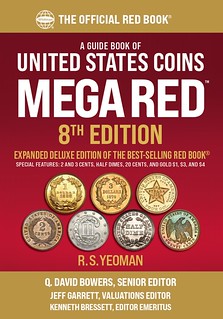 The eighth edition of Mega Red (the 1,504-page expanded Deluxe Edition of the Guide Book of United States Coins) devotes nearly 300 pages to a detailed study of U.S. two-cent pieces, copper-nickel three-cent pieces, silver trimes, half dimes, twenty-cent pieces, and $1, $3, and $4 gold coins.
The eighth edition of Mega Red (the 1,504-page expanded Deluxe Edition of the Guide Book of United States Coins) devotes nearly 300 pages to a detailed study of U.S. two-cent pieces, copper-nickel three-cent pieces, silver trimes, half dimes, twenty-cent pieces, and $1, $3, and $4 gold coins.
One of the book's 13 appendices covers two series of related Canadian coins—five-cent silver pieces (roughly analogous to U.S. half dimes), and twenty-cent pieces. The appendix is based on the work of James A. Haxby (author of Whitman's Guide Book of Canadian Coins and Tokens) and Harvey B. Richer (author of 100 Greatest Canadian Coins and Tokens).
Canada and the United States share a long geopolitical border, and with it the two nations share culture and history going back to colonial times,
said Whitman publisher Dennis Tucker. For coin collectors on both sides of the border it's valuable to study, understand, and appreciate our shared numismatic life.
Haxby discusses connections between the coinage of the two nations: By the 1830s, Canada and the U.S. had delimited fairly well-recognized borders around the 45th parallel, and localized territorial wars had largely ceased. As commerce between the nations flourished the U.S. dollar and its gold multiples, silver fractionals, and copper subsidiaries quickly became a serious challenge to the British monetary system in Canada. That market reality was officially recognized in 1841 when the colonies of Upper Canada and Lower Canada united to form the Province of Canada. Both the British gold sovereign and the U.S. gold eagle ($10 coin) were made legal tender, the former at the rate of 24 and 1/3 shillings (C$4.8666), the latter at 50 shillings (C$10). The U.S. and Spanish (and former Spanish colonial) silver dollars were also made legal tender, at the rate of 5 shillings and 1 penny.
In 1857 the Province of Canada's Currency Act of 1854 was revised to establish a decimal monetary system as the sole basis for its economy.
Canada was confederated on July 1, 1867, when three British North American provinces—the Province of Canada, Nova Scotia, and New Brunswick—were united into the Dominion of Canada. The Province of Canada was split into Ontario and Quebec. (Since confederation, Canada has experienced numerous other territorial changes and expansions, resulting in the current constitutional monarchy under King Charles III, with ten provinces and three territories.)
Appendix I of Mega Red, eighth edition, explores this history and the mints that produced Canadian five-cent and twenty-cent coins (the British Royal Mint, the Heaton Mint, and the Ottawa Mint).
It includes a coin-by-coin study of silver five-cent pieces of the Province of Canada, New Brunswick, Newfoundland, and the Dominion of Canada. In the United States, half dimes were minted from 1792 to 1873. To the north, Canadian silver five-cent pieces, which a U.S. coin collector might think of as a half dime
(although there is no dime as a denomination in Canadian numismatics), were minted from the 1850s and as late as 1947. These coins are collectible as a companion series alongside U.S. half dimes,
said Tucker. Studying them affords a deeper understanding of North American economics and finance in the 1800s.
The appendix similarly covers Canadian twenty-cent pieces. In the United States this denomination was minted in just four years, from 1875 to 1878. The Province of Canada had issued the same denomination nearly a generation earlier, in 1858. As with the Canadian half dimes,
Canadian twenty-cent coins are interesting companion pieces to the United States series, and they offer much to contemplate. In addition to the Province of Canada, they were also minted for New Brunswick and Newfoundland. In 1912 Newfoundland's King George V twenty-cent silver coin was a final one-year issue, before twenty-cent coins were abandoned in favor of a twenty-five-cent denomination.
Within the coin-by-coin study, the Mega Red appendix discusses technical specifications, mintages and mintmarks, die varieties, royal portrait variations, patterns and fantasies, individual Specimen coins, and related Specimen coin sets issued from 1858 to 1921.
Mega Red is billed as the biggest, most useful Red Book ever.
It measures 7 x 10 inches and has 1,040 more pages than the regular edition. The larger size and increased page count combined make Mega Red five times bigger than the regular-edition Red Book. It prices more than 9,000 items in up to 13 grades each, with 50,000 individual values and more than 15,000 auction records covering circulated, Mint State, and Proof coinage. The book is illustrated with thousands of full-color images, including hundreds that are new to this edition.
MEGA RED: A Guide Book of United States Coins, Deluxe Edition, 8th edition
ISBN 0794849660
1,504 pages, full color, $59.95 retail
By R.S. Yeoman; Senior Editor Q. David Bowers; Valuations Editor Jeff Garrett; Editor Emeritus Kenneth Bressett
NEW BOOK: 2023 CANADIAN GOVERNMENT PAPER
The 2023 edition of Charlton's Canadian Government Paper Money book has been published -Editor
2023 CHARLTON CANADIAN GOVERNMENT PAPER MONEY
34th Edition, 2023
J. Rutkowski, Editor
The 34th edition has undergone several updates and additions. Prices have been updated to better reflect the current market. Census totals have been updated giving a better indication of scarcity.
ISBN 978-0-88968-435-5
Weight .85 kg
Dimensions 23 × 20.5 × 3.5 cm
For more information, or to order, see:
2023 CHARLTON CANADIAN GOVERNMENT PAPER MONEY
(https://coinstampsupplies.com/product/2023-charlton-canadian-government-paper-money/)
NOVEMBER 2022 NNP SYMPOSIUM ANNOUNCED
The NNP Symposia are highlights of the numismatic year, bringing great speakers direct to you via Zoom. Be sure to plan for the next one. Here's the announcement. -Editor
Newman Numismatic Portal Announces NNP Symposium November 17-19, 2022
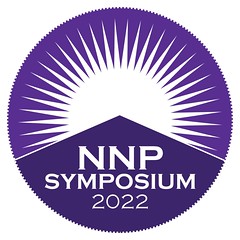 The Newman Numismatic Portal is pleased to announce the next NNP Symposium, which will take place November 17-19. This is a free, online event that brings together a variety of numismatic speakers and covers a wide array of numismatic subjects. Featuring approximately 25 presentations, attendees will easily find topics of interest. This is the fifth such event, which was launched in fall 2020 in response to the pandemic.
The Newman Numismatic Portal is pleased to announce the next NNP Symposium, which will take place November 17-19. This is a free, online event that brings together a variety of numismatic speakers and covers a wide array of numismatic subjects. Featuring approximately 25 presentations, attendees will easily find topics of interest. This is the fifth such event, which was launched in fall 2020 in response to the pandemic.
In the area of U.S. coins, our feature presentation will cover U.S. material in the cabinet of the American Numismatic Society (ANS). The ANS holdings in this area are both substantial and surprising. The financier J.P. Morgan made sizable donations to the ANS collection in the beginning of the 20th century, and over time many others have additionally contributed to this important New York repository. Jesse Kraft, the ANS Resolute Americana Assistant Curator of American Numismatics, will be on hand to answer audience questions following this presentation.
Representing another important institutional collection, Benjamin Hellings, the Jackson-Tomasko Associate Curator of Numismatics at Yale University, will also be presenting. Yale recently opened a new space, the Bela Lyon Pratt Gallery, to exhibit materials from one of the oldest collections in the United States. Among other speakers, Chris McDowell will share new details from his continuing research on the Betts medal series, while Kevin Vinton of Stack's Bowers will present highlights of the incomparable Syd Martin collection. Matthew Tavory, representing the next generation of numismatists, will speak on coins and the history of the Revolution.
NNP Symposium attendees may register at https://nnpsymposium.org, and a full list of speakers will be posted at https://nnpsymposium.org/schedule as the event draws nearer. Registrants will receive Zoom links shortly before the event.
U.S COIN SCALES AND COUNTERFEIT COIN DETECTORS
The latest addition to the Newman Numismatic Portal is the Newman=Mallis book, U.S Coin Scales and Counterfeit Coin Detectors. Project Coordinator Len Augsburger provided the following report. Thanks. -Editor
Newman Portal Adds U.S Coin Scales and Counterfeit Coin Detectors
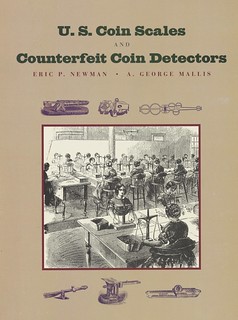 In 1999, Eric P. Newman and George Mallis teamed up to publish U.S Coin Scales and Counterfeit Coin Detectors. The authors begin with a history of scales for coins stretching back to the second millennium before Christ. The book comprehensively covers all scales and counterfeit coin detectors for which United States patents were issued, and many that never received patents. The authors focus on the experience of one inventor, John Allender, who, after many tries, was finally able to secure a patent for his machine, which combined high accuracy with a low price, and thus became successful in the marketplace. This work has recently been scanned by Newman Portal and is now available online.
In 1999, Eric P. Newman and George Mallis teamed up to publish U.S Coin Scales and Counterfeit Coin Detectors. The authors begin with a history of scales for coins stretching back to the second millennium before Christ. The book comprehensively covers all scales and counterfeit coin detectors for which United States patents were issued, and many that never received patents. The authors focus on the experience of one inventor, John Allender, who, after many tries, was finally able to secure a patent for his machine, which combined high accuracy with a low price, and thus became successful in the marketplace. This work has recently been scanned by Newman Portal and is now available online.
Unlike most other Newman publications, this title was self-published. Newman had four hundred copies of the book printed in early 1999 by Creative Printing Services in St. Louis; these were marketed at $39.50 per copy beginning in March of that year. Newman noted in correspondence to Mallis on September 29, 1998, The pages will be printed on 2 sides because the bulk of the book if printed on one side would be too heavy and difficult to read. Illegal photocopying of our pages will be much more difficult if printed on two sides
(this, obviously written before two-sided copying was ubiquitous). Sales were slow, with just over a hundred copies sold by the end of the following year. Newman's unsold books were ultimately distributed by numismatic booksellers Kolbe & Fanning, where they remain available for those desiring a hardcopy.
Link to U.S Coin Scales and Counterfeit Coin Detectors:
https://archive.org/details/1999uscoinscalesandcounterfeit/
Link to Eric P. Newman video American Counterfeit Coin Detector Devices,
from the 1990 ANA convention:
https://archive.org/details/ANA90016AmericanCounterfeitCoinDetectorDevices
A VIRGINIA COINAGE BIBLIOMYSTERY
Len Augsburger writes:
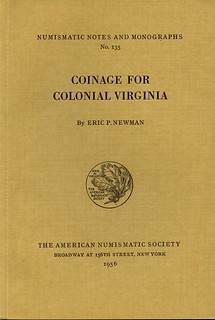 "In 1956, Eric P. Newman published Coinage for Colonial Virginia with the American Numismatic Society and followed up with Additions to Coinage for Colonial Virginia in 1962. Newman and Sanford J. Durst discussed the possibility of reprinting Coinage for Colonial Virginia in 1980. Little progress was made, and, in correspondence from Newman to Durst on June 18, 1986, Newman insisted on having any reprint incorporate new findings even if new typesetting and layout was necessary. This was not entirely consistent with the Durst Publications model, which was more focused on reproduction and distribution than editing and graphics work. Newman concluded by observing
"In 1956, Eric P. Newman published Coinage for Colonial Virginia with the American Numismatic Society and followed up with Additions to Coinage for Colonial Virginia in 1962. Newman and Sanford J. Durst discussed the possibility of reprinting Coinage for Colonial Virginia in 1980. Little progress was made, and, in correspondence from Newman to Durst on June 18, 1986, Newman insisted on having any reprint incorporate new findings even if new typesetting and layout was necessary. This was not entirely consistent with the Durst Publications model, which was more focused on reproduction and distribution than editing and graphics work. Newman concluded by observing I am trying to cooperate with you but can not get pleasure out of other than a top quality publication.
"In 1956, Eric P. Newman published Coinage for Colonial Virginia This work is listed in the International Standard Book Number (ISBN) catalog under the title Coins of Colonial Virginia with a publication date of 1990 (ISBN #9780915262670), but no copies have been verified. It is unlisted in the Newman 1992 library inventory and is not present in the ANS or ANA libraries. I checked with the authority of Virginia coinage, Roger Moore, who was similarly unaware of the work. Can an E-Sylum reader point to a physical copy?"
Link to ISBN entry for Coins of Colonial Virginia:
https://isbnsearch.org/isbn/9780915262670
Good question - has anyone seen one of these? It could have been that Durst registered the name but then abandoned the project. -Editor
VIDEO: MIKE BEAN AND THE SPIDER PRESS
These are selections from the David Lisot Video Library that feature news and personalities from the world of coin collecting. David has been attending coin conventions since 1972 and began videotaping in 1985. The Newman Numismatic Portal now lists all David's videos on their website at:
https://nnp.wustl.edu/library/multimediadetail/522852
Here's one with retired BEP printer Mike Bean demonstrating the spider press at the recent FUN show. -Editor
Spider Press Prints Lincoln Lithographs at FUN Summer Coin Convention 2022.
VIDEO: 7:27.
Mike Bean, Retired, Bureau of Engraving & Printing,
David Lisot, Interviewer, CoinTelevision.com.
July 8, 2022.
The technology that printed America's bank notes in the 1800's was on display at the Florida United Numismatists Summer Coin Convention. Mike Bean brought the Spider Press and created collectibles for the show.
"If you collect bank notes you will appreciate the series of steps required to produce large size bills. Mike Bean is a great numismatic icon doing displays of this old-time technology. This was an event at the Florida United Numismatists Convention in July. More reasons to go to a coin show!"
An excerpt of the video is available for viewing on the Coin Television YouTube Channel at:
https://youtu.be/81u9K7B_bzc
WHERE WERE ELIZABETH II CORONATION MEDALS STRUCK?
Last week Martin Purdy asked for more information on a 1953 Elizabeth II Coronation medal believed to have been struck in Canada. John Regitko submitted these thoughts. Thanks! -Editor
To come up with the answer, one should look for the possible minters that can handle such an order. I mentioned the following Canadian minters in my columns in Canadian Coin News:
- Canadian medals have been struck in the past by:
- Canadian Artistic Dies/Lombardo Mint (Sherbrooke)
- Elliott & Bishop
- Birks (Toronto)
- Franklin Mint (Mississauga)
- Interbranch International Mint (Mississauga)
- Jacques Cartier Mint (Aurora)
- Johnson Matthey (Brampton)
- Lasqueti Mint (Lasqueti Island)
- Sherritt Mint (Fort McMurray)
- Steve Kelly and Barry Much
- Wellings Mint (Scarborough)
- Pressed Metal Products (Vancouver)
- Great Canadian Mint (Edmonton)
- Mississauga Mint (Mississauga)
- Rideau Recognition Solutions (Montreal)
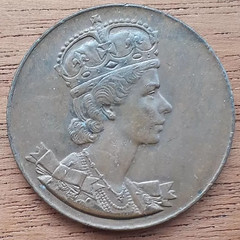
When you eliminate the ones that were not in existence in 1953 (they had either gone out of business or absorbed by another) and the ones that were incapable of handling such a large order in the limited time available, it didn't leave much of a choice. (Today, only the last three still exist.)
All of the above were privately owned Mints. However, today we completely forget that at one time, the Royal Canadian Mint was a big player in the large-volume medal business, whether for private corporations or government agencies at the national, provincial or civic level.
I recalled the Royal Canadian Mint's involvement in the past and ask my contact at the Mint about the history of the Coronation medal. He pointed me in the right direction.
The answer appears in a book written by James Haxby entitled Striking Impressions.
It includes the following text, from Chapter 17 A new Queen graces our coins,
which states that the mdal was struck by the Mint's Medals Branch. The RCM's 1953 Annual Report would also confirm this.
The text, which was provided to me by the RCM's Senior Manager, Public Affairs for republishing, states:
The Medal Section was also active in the 1950s. Britain had been disappointed by the response to the medal it had struck for the Coronation of King George VI. Therefore it did not plan a medal to commemorate the Coronation of Queen Elizabeth II. Canada, which had marketed the British medal in 1937, decided to create one of its own.
Since Britain was not producing a medal, Canada had more than the usual freedom of choice in the matter of selecting a suitable obverse. Twenty-seven possibilities had been prepared in Britain by individual designers and firms, and passed on to the Official Coronation Medal Panel. From these the Royal Mint Advisory Committee had chosen one for which it was willing to furnish dies. Canada, despite its freedom, chose this alternative valuing the convenience as much as the design.
The portrait was modelled by Mr. G.H. Paulin of London. It showed Queen Elizabeth crowned and robed, facing right. It was distinctive for its lack of surrounding inscription. An inscription surrounding the Royal Cypher surmounted by the St. Edward's Crown was included on the reverse. The whole of the reverse was modelled by the Mint engraver.
Unlike the procedure for the Royal Tour of 1939, no gold or silver presentation pieces were struck, but more than three million bronze medals were made for school children.
Aidan Work writes:
"There is one coin that uses the medal portrait on a coin. The 'P' on the obverse of this coin is NOT a mintmark, but a composition mark to indicate that this is struck on Nickel plated Steel at the Royal Canadian Mint in Winnipeg."
Thank you! -Editor
STRIKING IMPRESSIONS PRINT RUN
John Regitko provided this additional information on "Striking Impressions" and his own numismatic books. -Editor
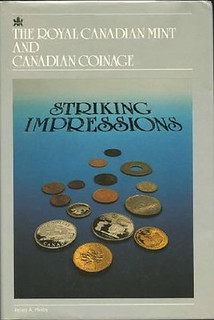 I was told by a former V.P. at the Royal Canadian Mint that this sort of glossy book with all the colour and printed on glossy paper would be considered a money-losing proposition. What made the book a possibility is that the Royal Canadian Mint agreed to purchase 2,000 copies, if memory serves me right.
I was told by a former V.P. at the Royal Canadian Mint that this sort of glossy book with all the colour and printed on glossy paper would be considered a money-losing proposition. What made the book a possibility is that the Royal Canadian Mint agreed to purchase 2,000 copies, if memory serves me right.
When I was chairing the upcoming 1981 CNA Convention, I asked the Mint what they had to give me to include in the registration kits. About a week later, a large delivery truck pulled up to my driveway with a skid of boxes. I had no idea what it was except that the shipper was the Royal Canadian Mint, Ottawa.
The waybill stated that the boxes contained a total of 500 books "Striking Impressions."
The reason they did such a thing for me is that I was the CNA's liaison to the RCM, a position that I had held well over a decade. They even designed the official Convention medal what turned out to be the most detailed coin or medal they ever produced, creating the dies and striking it. They only charged me for the pure cost of silver.
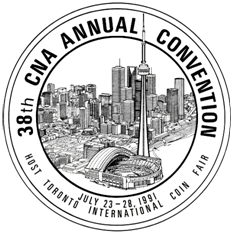 I intentionally say the Mint charged "me" and not the CNA because the CNA sold the rights to the convention to the Toronto International Coin Fair which I owned (the only time they had turned over their Convention to a private coin show…but it was the largest coin show in Canada at the time).
I intentionally say the Mint charged "me" and not the CNA because the CNA sold the rights to the convention to the Toronto International Coin Fair which I owned (the only time they had turned over their Convention to a private coin show…but it was the largest coin show in Canada at the time).
I visited the people at the Mint regularly, including getting to stick my nose into the minting presses, cockie cutter, blanking machine and everything else that went on, which enabled me to write a biweekly "Error & Varieties" column (I am now at column 353) and two books on errors produced by the RCM that sold out, thanks to the good publicity I received, including from The E-Sylum.
As a matter of fact, I am in the process of writing another book, dealing mainly with the old and new minting processes at the RCM and publishing a number of designs that were submitted by artists but not used on Canadian coins. It will also include the history of some well-known errors such as the 1967 "Diving Goose" dollars and other back-door jobs that originated at the Hull Plant of the RCM, including names of the people behind their distribution.
We'll look forward to the book!
"Striking Impressions" is a fine book, but a drug on the market. No wonder copies show up every time one turns around. -Editor
To read the earlier E-Sylum article, see:
NOTES FROM E-SYLUM READERS: SEPTEMBER 25, 2022 :
Elizabeth II Coronation Medals: Where Struck?
(https://www.coinbooks.org/v25/esylum_v25n39a09.html)
NOTES FROM E-SYLUM READERS: OCTOBER 2, 2022
On the Beginning and End of Centuries
David Gladfelter writes:
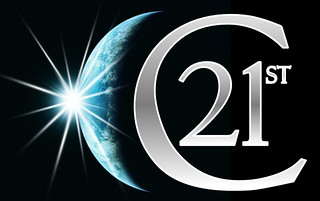 "People would disagree about Mr. Frazier having lived in parts of three centuries. That's because he died two months before the generally accepted starting date of the 21st century on January 1, 2001.
"People would disagree about Mr. Frazier having lived in parts of three centuries. That's because he died two months before the generally accepted starting date of the 21st century on January 1, 2001.
"Robert L. Hendershott (1898-2004) did achieve that amazing feat – John Wilson introduced me to him in 2002. However, my copy of his book on the 1904 St.Louis World's Fair, published in 1994, was signed by him that year to another collector, when he was a mere nonagenarian. Mr. Hendershott knew whereof he spoke, having attended the fair in person with his father."
To read the earlier E-Sylum article, see:
ARTHUR HENRY FRAZIER (1899-2000)
(https://www.coinbooks.org/v25/esylum_v25n39a14.html)
Undetectable Counterfeit Money
"I moderate a Facebook group called Fake coin / bank note alert - Lanka.
"Every other day the group gets such an advert with "Undetectable Counterfeit Money". I report it to Facebook as an unauthorized Sale/Other and Facebook automatically deletes it. Not sure why Facebook does not auto-detect themselves and delete/ban them. Getting sick and tired of that SPAM.
"Good you did not click on site."
To visit the Facebook group, see:
Fake coin / bank note alert - Lanka
(https://www.facebook.com/groups/221678426511822)
To read the earlier E-Sylum article, see:
LOOSE CHANGE: SEPTEMBER 25, 2022 : 100% Undetectable Counterfeit Money Online
(https://www.coinbooks.org/v25/esylum_v25n39a30.html)
On Tipping With Twos
Brad Karoleff writes:
"I too tip with $2 notes and have a funny story.
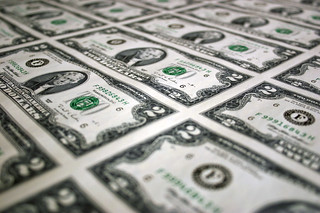 "I was in a local chili parlor (Skyline for Cincinnati aficionados) and tipped the young lady with $2's. She proceeded to ask me if they were real. I replied that they were not and that I was getting really good at making them. I offered to "prove it" to her. I had a sheet of 36 $2's in the trunk of my car which I retrieved to show to her. I unrolled the sheet and everyone working there stopped what they were doing and stared at the sheet. The manager soon got aggravated that nothing was getting done and I had to fess up. It was fun while it lasted......."
"I was in a local chili parlor (Skyline for Cincinnati aficionados) and tipped the young lady with $2's. She proceeded to ask me if they were real. I replied that they were not and that I was getting really good at making them. I offered to "prove it" to her. I had a sheet of 36 $2's in the trunk of my car which I retrieved to show to her. I unrolled the sheet and everyone working there stopped what they were doing and stared at the sheet. The manager soon got aggravated that nothing was getting done and I had to fess up. It was fun while it lasted......."
You and Woz would be great pals! -Editor
To read the earlier E-Sylum articles, see:
STEVE WOZNIAK'S PERFORATED PADS OF $2 BILLS
(https://www.coinbooks.org/esylum_v18n36a40.html)
TIME TO START PAYING WITH $2 BILLS
(https://www.coinbooks.org/v25/esylum_v25n38a27.html)
NOTES FROM E-SYLUM READERS: SEPTEMBER 25, 2022 : Tipping With Twos
(https://www.coinbooks.org/v25/esylum_v25n39a09.html)
Witness Marks and the Death of a Die
Bob Van Arsdell writes:
"The recent article in The E-Sylum about error coins prompted me to rearrange my publications stream. I've wanted to do a piece on ancient error coins because they're often ignored as an opportunity for research.
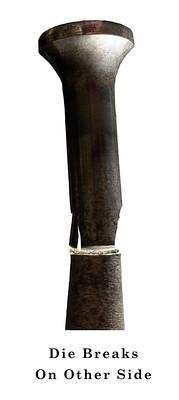 "It may be that all ancient coins look like error coins to most people. They're not round and they're usually struck off-center. However, once you spot an ancient error-coin, it gives you the same opportunity to learn about manufacturing methods as modern errors.
"It may be that all ancient coins look like error coins to most people. They're not round and they're usually struck off-center. However, once you spot an ancient error-coin, it gives you the same opportunity to learn about manufacturing methods as modern errors.
"So, I moved the article to the head of the list, thanks to the E-Sylum contributors.
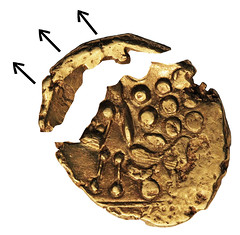 "The coin I've selected has
"The coin I've selected has witness marks
that reveal the catastrophic failure of a die as it happened. It may be one of the few to do this. The coin gives us insight in the way mint workers extended die-life. It certainly demonstrates that they were paying careful attention to their work.
"The article also suggests that Photoshop Editing Software has potential as an analytical tool for Numismatic research."
Excellent, well-illustrated article. I encourage everyone to read it. As it happens, we have a nice article on ancient errors elsewhere in this issue. -Editor
To read the complete article, see:
Death of a Die
(https://vanarsdellcelticcoinageofbritain.com/articles-numismatic_ccb3/van_arsdell_2022c_ccb3.html)
To read the earlier E-Sylum articles, see:
NEW BOOK: ERRORS AND VARIETIES ON CANADIAN COINS
(https://www.coinbooks.org/v25/esylum_v25n35a06.html)
DOUBLE-STRUCK MINT ERRORS
(https://www.coinbooks.org/v25/esylum_v25n35a26.html)
1792 Washington President Copper
Speaking of errors, Pete Smith pointed out that last week I somehow duplicated the image of the Washington Roman Head Cent from the Syd Martin collection. Our webmaster Bruce Purdue has corrected our article archive. Thanks, guys. Here's the missing image. -Editor
To read the earlier E-Sylum article, see:
SYDNEY F. MARTIN COLLECTION WASHINGTONIA
(https://www.coinbooks.org/v25/esylum_v25n39a17.html)
DALL-E COIN IMAGES
By now I think everyone has heard about DALL-E, the image synthesis tool that uses the latest artificial intelligence technology to generate images based on text prompts. Here's an excerpt from a recent Washington Post article and an image from an Ars Technica piece. -Editor
Since the research lab OpenAI debuted the latest version of DALL-E in April, the AI has dazzled the public, attracting digital artists, graphic designers, early adopters, and anyone in search of online distraction. The ability to create original, sometimes accurate, and occasionally inspired images from any spur-of-the-moment phrase, like a conversational Photoshop, has startled even jaded internet users with how quickly AI has progressed.
Five months later, 1.5 million users are generating 2 million images a day. On Wednesday, OpenAI said it removed its waitlist for DALL-E, giving anyone immediate access.
The introduction of DALL-E has triggered an explosion of text-to-image generators. Google and Meta quickly revealed that they had each been developing similar systems, but said their models weren't ready for the public. Rival start-ups soon went public, including Stable Diffusion and Midjourney, which created the image that sparked controversy in August when it won an art competition at the Colorado State Fair.
 Seemingly superficial generations like an
Seemingly superficial generations like an avocado chair
showed that OpenAI had built a system that is able to apply the characteristics of an avocado to the form factor and the function of a chair, Murati said.
The avocado-chair image could be key to building AGI that understands the world the same way humans do. Whether the system sees an avocado, hears the word avocado,
or reads the word avocado,
the concept that gets triggered should be exactly the same, she said. Since DALL-E's outputs are in images, OpenAI can view how the system represents concepts.
I couldn't resist the urge to try it out with some numismatic prompts. -Editor
Buffalo nickel with the legend "This is not a coin"
I'll give DALL-E a "B" on this one - it at least looks like a coin, has a Buffalo and a legend, just not the legend I wanted. -Editor
Pine tree shilling in palm of pilgrim's hand on Thanksgiving
Um, not even close. There are plenty of well-labeled Pine Tree Shilling images on the web. I'll give this a "D". -Editor
large rare gold coin on display in museum with people looking in amazement
I'll give this one an "A-". Not bad! -Editor
Gort the Robot walking through a coin show
I dunno - a "B" maybe... -Editor
Harvey Stack walking through a coin show with a cane
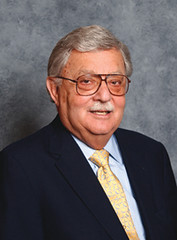
You aren't allowed to use the names of celebrities or politicians. I was wondering if it would actually find an image of the late coin dealer Harvey Stack. Maybe it's dumb luck, but it did get the suit and tie, grey hair and glasses. I'll give this a "B". Love the cane made out of a stack of coins! Very creative. When The E-Sylum starts selling merch, we'll have to stock some of those. Interesting that the cane comes with a top hat.
Wondering what DALL-E thinks The E-Sylum would look like, I tried text from our splash page, http://e-sylum.org/. -Editor
history and artistry of coins, medals, tokens or paper money, digital art
Guess we're kinda creepy... Happy Halloween. -Editor
To give it a try yourself, see:
DALL·E Now
Available in Beta
(https://openai.com/blog/dall-e-now-available-in-beta/)
To read the complete articles, see:
DALL-E image generator is now open to everyone
(https://arstechnica.com/information-technology/2022/09/openai-image-generator-dall-e-now-available-without-waitlist/)
AI can now create any image in seconds, bringing wonder and danger
(https://www.washingtonpost.com/technology/interactive/2022/artificial-intelligence-images-dall-e/)
Bonus robot article - Maillardet's automaton:
This Creepy Robot Just Showed Up at the Franklin Institute One Day
(https://www.thevintagenews.com/2022/09/20/maillardet-automaton/)
OCTOBER 2022 PAN SHOW EVENTS
The Pennsylvania Association of Numismatists coin shows keep getting bigger and better. Here's an announcement for the upcoming fall show. I expect to be there and hope to see many E-Sylum readers there. -Editor
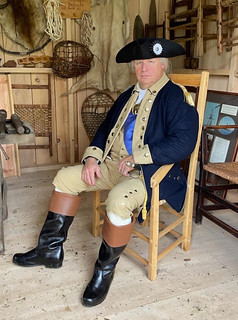 The Pennsylvania Association of Numismatists (PAN) Fall Coin Show and Convention is pleased to
announce the addition of George Washington as part of the PAN Living American History Program.
Benjamin Franklin (Patrick McBride), Abraham Lincoln (Dennis Boggs), and George Washington (Curt
Radabaugh) will be present at the Fall PAN Coin Show, October 20-22 at the
Monroeville Convention
Center, PA to talk about their roles in American History and their impact on our nation's coinage and
currency. They would like to see young people, home schoolers, Colonial and Civil War reenactors, and
all history enthusiasts and numismatists come to this gathering to greet, chat and take photos.
The Pennsylvania Association of Numismatists (PAN) Fall Coin Show and Convention is pleased to
announce the addition of George Washington as part of the PAN Living American History Program.
Benjamin Franklin (Patrick McBride), Abraham Lincoln (Dennis Boggs), and George Washington (Curt
Radabaugh) will be present at the Fall PAN Coin Show, October 20-22 at the
Monroeville Convention
Center, PA to talk about their roles in American History and their impact on our nation's coinage and
currency. They would like to see young people, home schoolers, Colonial and Civil War reenactors, and
all history enthusiasts and numismatists come to this gathering to greet, chat and take photos.
Admission is free and open to the public! We are accepting donations to keep this program viable.
Checks may be made out to PAN and mailed to the address below or go to
www.PANcoins.org and click
the Donate to PAN
link. PAN Bourse Chair, Ed Hammond, Running Bear Coins is the PAN Living
American History fundraising chairman.
The Fall PAN Show will once again hold the Civil War Showcase hosted by authors Rick Lank and Becky Rush. They will conduct talks and displays that cover the coinage, currency, and gold bullion that was a vital part of Civil War history. Mr. Lincoln and General Sherman will be part of the discussion and folklore that surrounds money and banking.
The PAN Friday Lecture Series has a full line up of well known numismatists that include Carl Waltz Jr,
Author presenting Charles T. Steigerwalt: ANA Hall of Fame Inductee
, Dr. Lawrence C. Korchnak,
Numismatist and Author presenting Seige of Groningen: Birth of the Netherlands
, Ron Sirna, Esq,
Founder of the Toned Coin Collectors Society presenting Toning: Some Call It Tarnish, We Call It
Toning
, Michael Drabick, Numismatist presenting Should I Buy Bitcoin or Gold
, John Frost, Liberty
Seated & Barber Coinage Expert presenting Interesting Varieties on Liberty Seated Coinage
. The full
schedule with dates and times can be found on the PAN website.
www.PANcoins.org
The Competitive Collector Exhibit will feature many of the first place exhibits from the recent American Numismatic Association's World's Fair of Money. Exhibit Chairman Tom Corey reports close to 100 cases of quality numismatic material.
John Mercanti Plaster Sculpts to be auctioned at PAN Fall Banquet on Thursday evening October 20th at the LeMont Restaurant, Pittsburgh PA.
U.S. Mint 12th Chief Engraver John Mercanti has created two bas-relief plaster sculptures that will be the highlight of the PAN Benefit Auction to occur on the evening of Thursday October 20th during the Pennsylvania Association of Numismatists banquet that is held in conjunction with the PAN Fall Coin Show and Convention on October 20th thru 22nd Thursday, Friday and Saturday at the Monroeville Convention Center, Pittsburgh, PA.
The first sculpture is a beautiful likeness of 26th President of the United States, Theodore Roosevelt Jr. on Horseback. The piece is hand signed by Mr. Mercanti. His work is world-renowned and this sculpture of TR is a stunning example of his accomplished talent.
The second item is the First United States Mint Building hand signed by Mr. Mercanti. On April 2, 1792, Congress passed the Coinage Act, establishing the first national mint in the United States. Congress chose Philadelphia, what was then the nation's capital, as the site of our first Mint. This piece is a very high relief of our nation's first built federal structure.
The PAN Banquet will be held at the LeMont Restaurant on top of Mt. Washington overlooking the popular view of the City of Pittsburgh. Tickets and details can be found on the PAN website www.PANcoins.org or by calling PAN President Tom Uram at 412-418-0783.
Proceeds from the auction will benefit the PAN Living American History Program. Our PAN reenactors will be present at the banquet with remarks and will be available for photos.
VOCABULARY TERM: MAHOGANY FINISH
Here's another entry from Dick Johnson's Encyclopedia of Coin and Medal Terminology. I added the images. -Editor
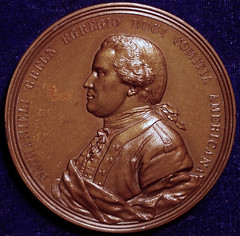
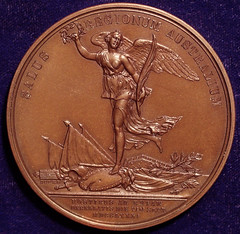
Nathaniel Greene mahogany finish medal
https://forums.collectors.com/discussion/1007285/mahogany-versus-the-yellow-bronze-finish-for-medals-and-the-nathaniel-greene-medal
Mahogany Finish. A deep, dark patina finish which ranges from chocolate brown to red-brown. (The color closely resembles that of mahogany wood, hence the name). It was extensively used by the United States Mint on all its bronze medals in the later half of the 19th century but was phased out (beginning 1900 and ceased by 1910) because it was so labor intensive and time consuming. It was accomplished by a double-heating process known as fire-bronzing. (It is said one could have ordered medals from the Mint in either the dark mahogany or the lighter patina finish during the 10-year transition period at the buyer's option.)
Fire-bronzing predated the highlight-by-oxidizing-and-relieving finishing process, developed by the French in the 1880s, which the U.S. Mint adopted in place of fire-bronzing. (Numismatists called this later finish yellow-bronze). A close approximation of the mahogany color was achieved in 1930 by the Medallic Art Company for the Second Issue of the Society of Medalists, Dionysus, by Paul Manship. It accomplished this dark brown bronze patina with chemicals (ferric nitrate) but this was still not the exact deep mahogany color that results from red lead and fire-bronzing used in the 19th century.
In addition to fire-bronze, fire-bronzing, see also patina, finish and finishing.
Reference:
M37 {1977} Julian, Introduction, p XXXV-XXXVII (35-37).
JOHN/JACK ROWE, AKA JAY ROE (1924-2000)
American Numismatic Biographies author Pete Smith submitted this article on California fractional gold collector/dealer John/Jack/Jay Roe/Rowe. Thanks! -Editor
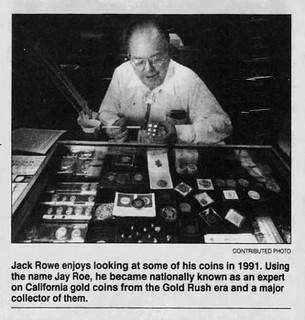 This week I was reviewing the listing for Jay Roe in American Numismatic Biographies and
discovered a couple of errors. They will be corrected in the next update.
This week I was reviewing the listing for Jay Roe in American Numismatic Biographies and
discovered a couple of errors. They will be corrected in the next update.
I got Jay's autograph in 1985. I would see him at coin shows around the area. His exhibit at our
coin show one year made a strong impression. It was called Metals in Numismatics
with
examples of coins struck in 24 different metals including a few very rare metals like niobium and
tantalum.
Jay and his wife contributed articles for World Coin News on World's Coinage Uses 24
Chemical Elements
published in 1992.
There is a Wikipedia entry for Coinage Metals
that makes reference to this article. If you do
not wish to read this in English, there are other options, A Google search give these options:
Kovane kovine; Metallirahat; Razenie Kovov; Metalli da conio; Logam duit syiling;
Munzmetalle; Kim loai duc tien; and ????????????.
Jay spent summers at his grandfather's lake home on Stoney Lake in Ontario. His grandfather
was a Princeton University professor and advisor to the Chinese and Japanese governments.
Jay's house was filled with mementos from his grandfather's frequent trips.
His father's business also required foreign travel and he would return home with small change accumulated during the trips. He gave the coins to Jay. His initial interest grew to an obsession.
He developed an interest in California fractional gold. He decided that he would have better access and buying opportunities as a dealer. He did business as Jay Roe California Gold from 1978 to 1996. The collection he assembled, with 580 pieces, is the finest such collection ever formed. He was a licensed pilot and collected Zeppelin coins, stamps and medals. He also formed an extensive collection of bolo ties.
Jay Roe pushed hard for a second edition of California Pioneer Fractional Gold by Walter Breen and Ronald J. Gillio, and persuaded Dave Bowers to publish it, sweetening the deal by agreeing to consign his collection to Bowers and Merena for auction once the book was out. Unfortunately, he died before writing began, but his collection was used for nearly all the illustrations. Robert D. Leonard Jr., with the assistance of Jay's widow Marieli and researcher Jack Totheroh, prepared the second edition published in 2003.
The Jay Roe Collection of California fractional gold was sold at auction by Bowers and Merena on September 14, 2003. The catalog identified the owner as John Westel Rowe.
Lot 137 of the sale was the highlight of the Roe Collection, an 1853-GG round gold dollar, BG-
604. It is called the Crested Eagle
variety and the finer of two known. [PCGS MS-62] Roe
bought it from the Goliad Corporation on August 26, 1991, for $100.000. At the Roe sale it
realized $80,500.
A search for Jay Roe
on the Newman Numismatic Portal shows 1753 citations.
Jack(1924-2000)
John Westel Rowe was born in Scarsdale, New York, on September 3, 1924. His father was Ward John Edward Rowe, Jr. (1895-1982). His mother was Laura Robinson Willoughby (1897- 1949). John served in the Navy during WWII. After the war he enrolled at the Massachusetts Institute of Technology (MIT) with a major in organic chemistry and a minor in geology. While at MIT, he was president of the Outing Club and enjoyed climbing, canoeing, sailing and skiing. Indoors, he participated in the bridge club and enjoyed square dancing. In 1947 he met his future wife who was president of the Swarthmore Outing Club.
He received a masters' degree from the University of Colorado in Boulder. While in Colorado he climbed to the top of 24 peaks with elevations over 14,000 feet. He received a Ph.D. from the Swiss Federal Institute of Technology in Zurich in 1956.
John married Mary Dorothy Theresa Lowenstein (1926-2020), also known as Marieli, at Riverside Church in New York City on June 26, 1949, and had three sons. He worked as a chemist for the U. S. Department of Agriculture Forest Products Laboratory at Madison, Wisconsin for 30 years.
He died in Madison, Wisconsin, and is buried at Forest Hill Cemetery.
A search for John Westel Rowe
on the Newman Numismatic Portal yields two citations.
Bob Leonard added these comments:
Jay was bursting with enthusiasm, like the "goingatumstrong" collectors of a century ago, and
figured out that the best way to advance his collection was to become a "dealer." He built a stock
and set up at shows, advertised in Numismatic News, etc., and other dealers would bring him
their coins to buy at wholesale. This usually worked, though Dave Bowers was wise to him and
refused to let him get away with a "dealer price" offer on one occasion.
The most amazing thing about this man was that, around 1955, he and Marieli were in a club
that drove from Istanbul to Baghdad, in ordinary cars, Fords, I believe. No electronics then, so
breakdowns could be repaired without too much difficulty, and of course the group brought
plenty of spare parts. This could not be repeated today, but they drove across Turkey, Syria, and
Iraq, a distance of over a thousand miles--a lot of it across desert. This was more of an adventure
than an archaeological tour.
WEXFORD MEDAL SELECTIONS OCTOBER 2022
Rich Jewell's Wexford Rare Coins and Medals eBay store features a number of great medals along with other numismatic items. Here are some that caught my eye this week. -Editor
Listing is for a 1830-David D'Angers,Sc.-Jean-Pierre de Beranger Medallion, BRONZE cast, 130MM
Obverse- a very high relief bust of J.P. De Beranger facing right, name behind head. Signed David 1830, beneath the bust.
Reverse- Blank.
A loop has been added to the reverse (at a later date).
Not found in the David D'Angers catalogue, but is recorded at the David D'Angers museum
Great relief - nice. -Editor
To read the complete lot description, see:
1830-David D' Angers, Sc.-JP De Beranger Medallion, Bronze cast, 130 mm
(https://www.ebay.com/itm/194414945763)
Listing is for a 1835-David D'angers Sc., Robespierre Medallion, bronze cast, 130mm. A very nice high relief, historical piece
Obverse-Robespierre facing left, his name incused behind his bust; signed David below the bust, 1835
Reverse-Blank
Reference: Museum de David D'angers
Another D'Angers piece. Nice work. -Editor
To read the complete lot description, see:
1835-David D' Angers, Sc.- Robespierre Medallion, cast bronze, 130mm
(https://www.ebay.com/itm/194415698335)
Listing is for a 1906-Theodore Spicer-Simson, Sc., Margaret Spicer-Simson Medallion, 4-1/2" Oval, bronze with a copper wash. This is quite the piece for a Spicer-Simson collector !
Unusual pose, with arms resting on a tabletop. Nice composition - I like it! -Editor
To read the complete lot description, see:
1906- Theodore Spicer-Simson, Margaret Spicer-Simson Medallion, 4-1/2"bronze etc
(https://www.ebay.com/itm/194517920897)
Listing is for a 1906-3rd International Conference of Americas medal, Eric Lindauer,sc., silver (argent edge marked), 45mm, Monnaie de Paris
Obverse-forward looking bust of Secretary of State, Elihu Root, U.S. of America 1906. Monogram of sculptor in lower right corner.
Reverse-legend:"TERCEIRA CONFERENCIA INTERNACIONAL AMERICANA-RIO DE JANERIO BRAZIL 1906"
You don't often see medals for the Secretary of State. A vital role, but overshadowed by the Presidency. This one is from a 1906 conference in Brazil. -Editor
To read the complete lot description, see:
1906-3rd International Conf. of Americas Medal, Eric Lindauer, Sc.,silver,45mm
(https://www.ebay.com/itm/194451063031)
Awesome two medal set, attributed to Julio Kilenyi, engraver. Gold medal(14K) for 50 yrs of service and silver medal for 35 years of service (awarded to Frank T. Horan) a U.S. Steel employee. Comes in a worn black fob
Growing up in Pittsburgh, there were a lot of U.S. Steel medals in dresser drawers around the neighborhood, and my family had one, too. But the gold ones are rare - I don't believe I've ever seen one in person. The storage case is nice, too. -Editor
To read the complete lot description, see:
U.S. Steel Service medals, two medals one gold(50yrs), one silver(35yrs) in fob
(https://www.ebay.com/itm/194381147274)
ARCHIVES INTERNATIONAL AUCTION 79B SELECTIONS
Here's a selection of items that caught my eye in the October 2022 Archives International Auction 79b. -Editor
Lot 1030: DuraNote Polymer Advertising Notes
To read the complete lot description, see:
DuraNote Polymer Banknote Predecessor Advertising Note Quintet
(https://auction.archivesinternational.com/DuraNote-Polymer-Banknote-Predecessor-Advertising-Note-Quintet_i46405351)
Lot 1034: Ceylon Postal Savings Certificate
To read the complete lot description, see:
Ceylon Postal Savings Certificate, Issued by the Government of Ceylon, ND (ca. 1940-50's) Specimen S
(https://auction.archivesinternational.com/Ceylon-Postal-Savings-Certificate-Issued-by-the-Government-of-Ceylon-ND-ca-1940-50-s-Specimen-S_i46405355)
Lot 1042: China Market Stabilization Currency
To read the complete lot description, see:
Market Stabilization Currency Bureau, 1915 Issued Banknote
(https://auction.archivesinternational.com/Market-Stabilization-Currency-Bureau-1915-Issued-Banknote_i46405363)
Lot 1058: Costa Rica 5 Colones
Great colors - I don't know why (my favorite color is blue), but I love this combination of colors. -Editor
To read the complete lot description, see:
Banco Anglo Costarricense, ND (1903-17), Remainder Banknote
(https://auction.archivesinternational.com/Banco-Anglo-Costarricense-ND-1903-17-Remainder-Banknote_i46405379)
Lot 1060: Czechoslovakia Reprint 1000 Korun
Great vignette - love the depth. -Editor
To read the complete lot description, see:
Republika _eskoslovenská. 1919 (1988). Archive Series Reprint Banknote.
(https://auction.archivesinternational.com/Republika-eskoslovensk-1919-1988-Archive-Series-Reprint-Banknote_i46405381)
Lot 1096: Germany Kaiserslautern City Loan Note
To read the complete lot description, see:
Kaiserslautern City Loan, 1870, Issued Banknote
(https://auction.archivesinternational.com/Kaiserslautern-City-Loan-1870-Issued-Banknote_i46405417)
Lot 1190: Russia State Currency Note
To read the complete lot description, see:
State Currency Note. 1922. Issue Banknote
(https://auction.archivesinternational.com/State-Currency-Note-1922-Issue-Banknote_i46405511)
Lot 1197: National Bank of Scotland
Another colorful note! -Editor
To read the complete lot description, see:
National Bank of Scotland. 1934-42 Issue Banknote.
(https://auction.archivesinternational.com/National-Bank-of-Scotland-1934-42-Issue-Banknote_i46405518)
For more lots, see:
AIA Sale 79B - TIMED INTERNET - U.S. & World Banknotes, Scripophily & Ephemera
(https://auction.archivesinternational.com/AIA-Sale-79B-TIMED-INTERNET-U-S-World-Banknotes-Scripophily-Ephemera_as84576)
THE BOOK BAZARRE
KÜNKER AUCTION SALE 377, 378 HIGHLIGHTS
Here's a press release with highlights from the upcoming Künker auction sales 377 and 378. -Editor
Auction 377 / e- Live Premium 378: The Salton Collection Part 4: Roman and Byzantine Coins
1,940 lots with Roman and Byzantine coins from the Salton Collection will be sold on 20 and 21 October 2022. They once belonged to Mark and Lottie Salton. There is a very special story behind these issues that cannot be told too often.
Mark Salton, née Max Schlessinger, was born into an old German coin dealer dynasty: his father Felix Schlessinger was one of the most renowned German coin dealers when the Nazis drove him out of his country. Felix Schlessinger was the second cousin of Leo Hamburger, who founded the most important German coin shop in Frankfurt am Main in the 19th century.
At this point, we would like to draw your attention to the brochure we published, in which Ursula Kampmann recreated the fate of the Hamburger / Schlessinger coin dealer dynasty. Her findings are based on vivid descriptions of the Hamburger and Schlessinger family members and reveal many details of the day-to-day business of a 19th-century coin shop. You can download the brochure at https://issuu.com/kuenkercoins/docs/kuenker_broschuere_salton-collection_en or order a print version from our customer services. We also produced a film about the family's history, which is available on YouTube at https://www.youtube.com/watch?v=p0sHdjLRkjk.
Mark and Lottie Salton were among the people who were expelled from Germany due to their Jewish faith, whose families suffered persecution, even death at the hands of German officials. Mark and Lottie Salton lost all their possessions to the Nazi regime and had to start all over in the United States. Nevertheless, they decided to give their coin collection to a German and a US auction house to sell it. The proceeds will benefit three non-profit organizations that work to document and publish the history of Jewish persecutions to fight discrimination against Jews.
Following Künker's highly successful auction of European coins from the Salton Collection in the spring, Roman and Byzantine coins will now be on offer as the 4th part of the collection. The collection's design is typical for the 20th century and it was built up starting in the 1950. At the time, a coin's quality wasn't as important as it is today. Collectors rather focused on rarity, style, motifs and perfectly centered pieces, paying less attention to whether it was the best-preserved specimen out there. Therefore, the material is very mixed. There are FDC coins but also very fine items. Künker takes today's market habits into account by splitting the material into an on-site public auction, which will be held on Thursday 20 October, and an e-Live Premium Auction, taking place on the following day starting at 3 p.m. in the digital space. Both auction parts – auction 377 and e-Live Premium Auction 378 – are published in one auction catalog.
To order a catalog contact Künker, Nobbenburger Straße 4a, 49076 Osnabrück; phone: +49 541 / 962020; fax: +49 541 / 9620222; or via e-mail: service@kuenker.de. You can access the auction catalogs online at www.kuenker.de. If you want to submit your bid from your computer at home, please remember to register for this service in good time.
No. 5521: Roman Republic. C. Numitorius. Denarius, 133 BC. Very rare. Very fine. Estimate: 2,500 euros
No. 5621: Roman Republic. C. Iulius Caesar. Denarius, 41 posthumous, 41 BC. Very rare. Extremely fine. Estimate: 3,000 euros
No. 5657: Roman Republic. Octavian / C. Iulius Caesar. Dupondius, 38 BC, Italian mint. About extremely fine. Estimate: 1,250 euros
No. 5721: Claudius, 41-54. Cistophorus, 51, Ephesus. Rare. About extremely fine. Estimate: 2,000 euros
No. 5752: Vespasianus, 69-79. Aureus, 69/70. Very rare. About extremely fine. Estimate: 10,000 euros
No. 5830: Hadrian, 117-138. Aureus, 124/5. From the Ryan Collection, Glendining auction (1951), No. 1761. Very rare. About extremely fine. Estimate: 10,000 euros
No. 5885: Lucius Verus, 161-169. Aureus, 163/4. From the Lambros Collection, Hirsch auction XXIX (1910), No. 1105. Very rare. Extremely fine. Estimate: 12,500 euros
No. 5892: Commodus, 177-192. Aureus, 178. Very rare. Extremely fine. Estimate: 12,500 euros
No. 5902: Pertinax, 193. Sestertius. Very rare. Fields slightly smoothed, otherwise extremely fine. Estimate: 10,000 euros
No. 5916: Septimius Severus, 193-211. Aureus, 202-210. Very rare. About extremely fine. Estimate: 12,500 euros
No. 5953: Diva Iulia Domna. Denarius, 218. Very rare. Very fine / About extremely fine. Estimate: 750 euros
No. 5967: Maximinus Thrax I, 235-238. Quinarius, 236/7. From Cahn auction 35 (1913), No. 493. Very rare. Extremely fine / About extremely fine. Estimate: 2,500 euros
No. 6898: Burgundy. Sigismund, 516-524. Solidus on behalf of Iustinus I, after 518. Very rare. Extremely fine. Estimate: 10,000 euros
For more information, see:
https://www.kuenker.de/en
NUMISMATIC NUGGETS: OCTOBER 2, 2022
Here's a selection of interesting or unusual items I came across in the marketplace this week. Tell us what you think of some of these. -Editor
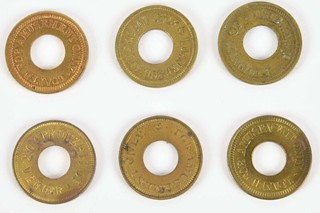 This is an extremely large lot of original Mills slot machine tokens.
This is an extremely large lot of original Mills slot machine tokens.
Condition: (Good).
Item Dimensions: Each: 3/4" Dia.
Looks like a dug hoard of Chinese cash! -Editor
To read the complete lot description, see:
LARGE LOT OF 5¢ MILLS TOKENS.
(https://auctions.morphyauctions.com/LARGE_LOT_OF_5__MILLS_TOKENS_-LOT550993.aspx)
Abraham Lincoln 1809-1865, patinated bronze bas relief plaque, signed and dated "Copyright 1907 by V.D. Brenner" and with Brenner's cipher lower right, a right facing profile image of the President, having the original attached bronze backing with back stand and hanging loop, 9 1/2" x 7". Minor surface scratches. Likely as a result of this image, President Theodore Roosevelt asked Brenner to design a new Lincoln cent to be issued in conjunction with the 100th anniversary of his birth.
A classic and popular item, great for display. -Editor
To read the complete lot description, see:
VICTOR DAVID BRENNER (1871-1924) BRONZE LINCOLN PLAQUE
(https://www.invaluable.com/auction-lot/VICTOR-DAVID-BRENNER-1871-1924-BRONZE-LINCOLN-P-5001-c-BBF4E73978)
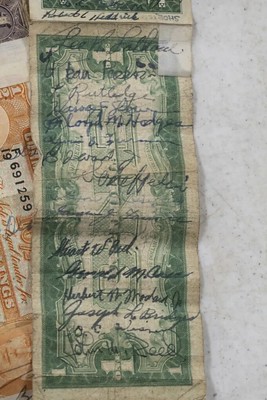 Collected by Jack Tippit, 13th Army Air Force, Pacific Theatre, WWII. A Pilot's good luck token, you were asked for your "Short Snorter" when you entered a bar. If you could not produce one, you had to buy a round of drinks for the house, but someone would provide your 'starter'. Currency from many countries and Occupied Zones, with many signatures of other air crews. Twelve feet long, (25) bills taped with medical tape, mostly from Japanese Occupied countries. Jack D. Tippit flew combat missions as a B-24 pilot in the Southwest Pacific in World War II and jet aircraft in the Korean War. He never lost his affection for airplanes and airmen, and remained in the Air Force Reserve. He retired as a colonel in 1974.
Collected by Jack Tippit, 13th Army Air Force, Pacific Theatre, WWII. A Pilot's good luck token, you were asked for your "Short Snorter" when you entered a bar. If you could not produce one, you had to buy a round of drinks for the house, but someone would provide your 'starter'. Currency from many countries and Occupied Zones, with many signatures of other air crews. Twelve feet long, (25) bills taped with medical tape, mostly from Japanese Occupied countries. Jack D. Tippit flew combat missions as a B-24 pilot in the Southwest Pacific in World War II and jet aircraft in the Korean War. He never lost his affection for airplanes and airmen, and remained in the Air Force Reserve. He retired as a colonel in 1974.
Twelve feet long! Amazing - is this the King of Short Snorters? Anyone aware of a longer one? -Editor
To read the complete lot description, see:
A WWII "SHORT SNORTER", PROPERTY OF CARTOONIST JACK TIPPIT
(https://www.liveauctioneers.com/item/137188211_a-wwii-short-snorter-property-of-cartoonist-jack-tippit)
Congressional Gold Medal Ceremony Program
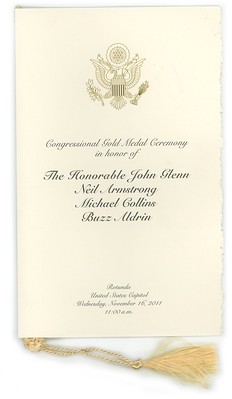 Congressional Gold Medal Ceremony official program honoring John Glenn, Neil Armstrong, Michael Collins and Buzz Aldrin on November 16, 2011.
Congressional Gold Medal Ceremony official program honoring John Glenn, Neil Armstrong, Michael Collins and Buzz Aldrin on November 16, 2011.
This program is also accompanied by a 2016 Celebration of Live Service program for John Glenn.
Very cool numismatic ephemera. -Editor
To read the complete lot description, see:
CONGRESSIONAL GOLD MEDAL CEREMONY PROGRAM HONORING JOHN GLENN, NEIL ARMSTRONG, MICHAEL COLLINS & BUZZ ALDRIN ON NOV. 16, 2011
(https://bid.jg.limited/lots/view/5-E618Z/congressional-gold-medal-ceremony-program-honoring-john-glenn-neil-armstrong-michael-collins-buzz-aldrin-on-nov-16-2011)
THE ORIGINAL ERROR COINS
Error coins are a window into the minting process, and knowledge of mint errors is a key component of numismatic education. While most articles published nowadays discuss modern errors, errors are as old as coinage itself. With permission we're publishing this excerpt of an article by Jason Kim on "The Original Error Coins" in the September-October 2022 issue of ErrorScope, the official publication of the Combined Organizations of Numismatic Error Collectors of America (CONECA). Thanks to Editor Allan Anderson for providing the text and images. -Editor
As long as humans have been making coins there have been errors along with them. Those die cracks, brockages, off-strikes and double strikes were made thousands of years ago with bronze dies and hammers. In this article I will go into some of the errors that were produced at mints now long gone, by people long forgotten.
Striking Errors
Brockages:
Brockage are one of my favorite ancient errors. They were caused by an already struck coin striking a blank flan rather than the die. This led the design to transfer as an incuse image onto one side of the flan, while the other side maintained the intended image. These errors are very dramatic and noticeable compared to other coins and are fascinating to look at. When you've never seen an ancient brockage, it's a little eerie seeing how a modern problem was also a problem thousands of years ago.
This coin of Antoninus Pius exhibits a brockage. Notice a reversed image of the obverse is incused on the reverse.
This denarius of the Roman Republic shows a clear brockage.
Off-Center/Misaligned Die Strikes:
While finding an off-center coin today is a treat, you'll start to notice it's not the same for ancient coins. A majority of ancient coins have some form of off-center or misaligned die strike as they were never struck the same. Usually these errors detract from the value of the coin as most people would prefer the perfectly centered versus the off-centered one.
This Macedonian silver coin was struck with its obverse misaligned.
This Tetradrachm of Ephesos exhibits a misaligned die strike.
This Denarius of Octavian presents a nice off-center strike.
For more information about CONECA, see:
https://conecaonline.org/
RARE PORTUGUESE GOLD COIN FOUND
This press release from Noonan's describes a metal detectorist's find of a rare Portuguese gold coin. -Editor
It was 6am on the 5th of July, a bright summer's morning that 62-year-old Mick Edwards went out with his newly-acquired Deus II metal detector, his only companions were rabbits and a herd of deer in the pasture field.
Mick, who lives in Peterlee in County Durham, works as a Civil Servant and has been metal detecting for ten years. He found it has helped him overcome his illness by being more mobile. As he explained: I was staying on the farm near Etchilhampton in Wiltshire with my wife after celebrating 35 years of marriage from the day before. So far I had only found some broken crotal bells, so I walked to the top of the field for a final effort before breakfast, taking just three more steps I received a clear signal which sounded like a large copper coin.
After digging five inches, then a further five inches and still nothing, he used his pin-pointer probe to locate the signal and saw the edge of a coin at the bottom of the hole. To his astonishment it was a huge gold coin 36 millimetres in diameter and weighing over 35 grams.
He continued: I was dumbstruck and just sat looking at the coin unable even to breathe. I could see the cross on the coin and thought it was probably Spanish but later found out it was Portuguese from the Kings name Manuel.
The massive coin is a 10 Cruzados piece from the reign of Manuel I (1495-1521) and struck at Lisbon with gold recovered by Vasco de Gama from his voyages to Africa and India. It is the first to ever be found in Britain. This was at Etchilhampton in Wiltshire, on land which belonged to the Ernle family from 1489 until 1928. The coin that is estimated at £20,000-30,000 will be sold by Mayfair auctioneers Noonans on Thursday, September 29, 2022 on the second day of a two-day sale of Coins and Historical Medals. Mick will be sharing the proceeds from the sale with the landowner and his wife is compiling a list of how she would like to spend the money!
As Nigel Mills, Consultant (Artefacts and Antiquities) at Noonans explains: The coin features the crowned royal arms of Portugal on the obverse with the cross of the order of Christ on the reverse with the latin legend translated ‘In this sign shall we conquer,' with a test punch on the reverse. In England at this time the largest gold coin was a Sovereign which weighed 15.3 grams so this coin is more than double that in weight, so would have had a value greater than two pounds.
The coin sold Thursday for a hammer price of £16,000. It attracted bidders in the USA and Canada but was purchased by a buyer in Japan. -Editor
To visit the Noonan's website, see:
https://www.noonans.co.uk/
WHERE THE GOVERNMENT MAKES CENTS
Denver's Gazette recently published an article about a visit to the Denver Mint - here's an excerpt. Check out the full article and photo gallery online. -Editor
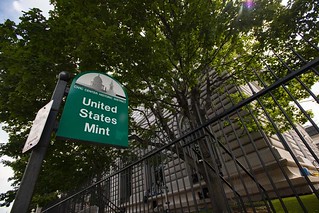 Somewhere between your couch cushions or the cupholders of your car, in a piggy bank or a wishing well or on the sidewalk of any street, there's a penny or a nickel or a dime or a quarter with an inconspicuous
Somewhere between your couch cushions or the cupholders of your car, in a piggy bank or a wishing well or on the sidewalk of any street, there's a penny or a nickel or a dime or a quarter with an inconspicuous D
beside the head of a president.
That's D
for Denver. Specifically, for the Denver Mint.
And somewhere inside the white, ornate block of a building in the heart of the Mile High City, there's a charming, retired teacher-turned-tour guide cracking his usual line.
Now,
Joe Blackman says to his 14 guests, we're going to show you where the government makes cents.
Welcome to one of the land's six U.S. Mint facilities, for more than a century manufacturing the change that makes the national economy go around. But only two make circulating coins: Philadelphia provides for populations east of the Mississippi River, while Denver delivers for those west.
The two Mints are itinerary stops for tourists. They come with an obvious curiosity, one that might've been sparked amid the coin shortage of the pandemic, and one that might be somehow poignant in this age of digital commerce, when the coin seems all too fated for those dark spaces of couches and crummy curbs.
People want to see how their money is made,
Blackman says. It's exciting for them.
The technology has changed since the first silver and gold coins were struck here in 1906 along Colfax Avenue. But the process is much the same. On tours, people watch as man and machine work.
Massive metal sheets are fed into blanking presses that punch the shape of coins — kind of like giant cookie cutters,
Blackman says during the tour. The blanks, he says, are bound for a furnace heated to 1,700 degrees. That softens the material for proper ridging around the edges and stamping of heads and tails.
We can do 750 coins per minute,
Blackman says. We make 25 to 30 million of them every day.
At the Denver Mint, tourists start in an exhibit displaying ancient money. Turquoise of the Egyptian pharos. Jade of the Aztecs. A boar tusk used in New Guinea and shells used in Asia. Bronze lepton issued by Pontius Pilate of Judea.
It all recalls something the Denver Mint's boss, Johnson, has wondered:
I think about the coins that people find and collect from the Roman Empire, and I think about the coins made here, and I wonder what people will be looking at 1,000 years from now, 2,000 years from now. And I can't help but wonder if people will know about Denver, Colorado, if nothing else because there's that ‘D' on the coin.
To read the complete article, see:
Where the government makes cents: Welcome to the Denver Mint
(https://gazette.com/life/in-the-heart-of-denver-a-minting-tradition-as-old-as-america/article_1d0430ae-2fc3-11ed-9c7a-ffa62e94b0d0.html)
KING CHARLES III COIN DESIGNS REVEALED
Dick Hansom passed along this BBC News article about the new King Charles III coin designs. Thanks also to David Pickup and Arthur Shippee. -Editor
New coins featuring the portrait of King Charles have been revealed, with a 50p carrying his image entering general circulation within weeks.
BBC News was given a first glimpse of the 50p and a commemorative £5 Crown which include an image of the King by British sculptor Martin Jennings.
The coins follow centuries of tradition with the monarch now facing left - the opposite way to his predecessor.
As with previous British kings, and unlike the Queen, he wears no crown.
King Charles personally approved the effigy, and was understood to be pleased with the likeness.
The coins will be sold to collectors by The Royal Mint from early next week. The 50p coin will be available for general use well before the end of the year, distributed according to demand by banks, building societies and post offices.
The official portrait was designed to give an accessible look to the King, and the same is true of the inscription.
Previous British monarchs have been denoted on the inscription using the Latin version of their name. However, the new coins say Charles III rather than Carolus.
The full inscription surrounding the effigy reads "CHARLES III • D • G • REX • F • D • 5 POUNDS • 2022", shortened from Latin, which translates to "King Charles III, by the Grace of God, Defender of the Faith".
The reverse of the new £5 coin shows two new portraits of the Queen, charting her journey from a young monarch to a long-standing head of state.
On the 50p coin, the reverse is a copy of the design used on the 1953 Crown struck to commemorate the Queen's coronation.
King Charles's portrait is the first coin design undertaken by Martin Jennings, but his public sculptures include poets John Betjeman, in St Pancras Station in London, and Philip Larkin in Hull.
He used photographs to come up with the design, rather than the King sitting for a specific portrait.
To read the complete article, see:
King Charles: New coins featuring monarch's portrait unveiled
(https://www.bbc.com/news/business-63073983)
David Pickup adds:
"It is interesting the legend has the English version of his name Charles. The name Elizabeth was used on her coins but George V, VI and Edward VIII all used the Latin versions. Victoria is the same in both languages.
"Both kings Charles I and Charles II used Carolus."
David passed along a link to the Royal Mint's home page:
https://www.royalmint.com/
Aaron Oppenheim passed along an article with additional launch ceremony images. Thanks. -Editor
To read the complete article, see:
UK Royal Mint reveals King Charles III coin portrait
(https://www.foxbusiness.com/economy/uk-royal-mint-reveals-king-charles-iii-coin-portrait)
To read the earlier E-Sylum article, see:
ON MONARCH PORTRAITS, PRONOUNS AND NAMES
(https://www.coinbooks.org/v25/esylum_v25n38a23.html)
ROB THE PARACHUTING DOG'S MEDALS FOR SALE
It's been quite some time since the sale of a Dickin medal. This article describes the upcoming sale of one of the most important Dickin Medals, awarded to Rob the Parachuting Dog. -Editor
A medal awarded to a Shropshire dog which was parachuted behind enemy lines on SAS missions is going up for auction.
The black and white Collie Retriever, Rob, originally from Colemere Farm near Ellesmere, was volunteered as a war dog during the Second World War.
He took part in 20 parachute descents throughout the war, and was awarded the PDSA Dickin Medal for Gallantry, otherwise known as the Victoria Cross for animals, as well as the RSPCA Red Collar for Valour, for his outstanding service.
The Dickin Medal will be auctioned on Wednesday, October 12, by Noonans – with a guide price of £20,000 to £30,000.
Rob's descents were made while serving with Infantry in North Africa and the 2nd SAS Regiment.
The proceeds of the auction will be given to the Taylor McNally Foundation.
The medal is being sold with an extensive archive including Rob's collar, a portrait painting, photographs, certificate, manuscripts, books and letters.
Rob was bought as a puppy from Colemere Farm near Ellesmere in 1939 for five shillings, and lived his early years with the Bayne family of nearby Tetchill as their farm dog and pet.
His owners volunteered him as a War Dog in 1942 and he was signed up on May 19 of that year.
Following action in the North Africa campaign, from September 1943, Rob served with the SAS, the first war dog to do so.
With the regiment, he took part in operations in Italy, parachuting in on sabotage missions.
Christopher Mellor-Hill, Head of Client Liaison at Noonans said: Rob the Parachuting Dog is the most famous of all the Dickin Medal recipients and we are delighted to be offering his medals on behalf of the family who owned him.
"Over the years books have been written about him and he even featured on the front page of the Radio Times. We believe this to be the most important Dickin Medal to ever be sold at auction.
Instituted by Maria Dickin, CBE, the founder of the People's Dispensary for Sick Animals (PDSA), in 1943, the Dickin Medal has since been awarded on 71 occasions – 32 of them going to pigeons, 34 to dogs, four to horses and one to a cat.
The vast majority – and all those awards to pigeons – were granted in respect of acts of bravery in the Second World War, but more recently a number of awards have been made to Arms and Explosives Search Dogs of the Royal Army Veterinary Corps for their gallantry in Iraq and Afghanistan.
To visit the Noonan's website, see:
https://www.noonans.co.uk/
To read the complete article, see:
Medals awarded to incredible SAS parachute dog expected to raise more than £20k at auction
(https://www.shropshirestar.com/news/local-hubs/oswestry/ellesmere/2022/09/25/medals-awarded-to-incredible-sas-parachute-dog-expected-to-raise-more-than-20k-at-auction/)
A Daily Mail article has additional information and images. -Editor
To read the earlier E-Sylum article, see:
Bravery medals of parachuting SAS dog are tipped to fetch £30,000 after he was awarded the animal Victoria Cross for being dropped behind enemy lines in WW2 (and a lifetime supply of biscuits)
(https://www.dailymail.co.uk/news/article-11238723/Medals-parachuting-SAS-dog-tipped-fetch-30-000-awarded-animal-Victoria-Cross.html)
ANOTHER ALTERED NORTH AFRICA NOTE
Last week we discussed an MPC Gram article by Larry Smulczenski on altered North Africa silver certificates. This week's issue (Series 23 No. 2542, 1 Oct 2022) includes a follow-up. It is republished here with permission. Thanks! -Editor
After I wrote the article about the ten-dollar North Africa note that was altered to look somewhat like a ten-dollar New York Federal Reserve Bank Note, I went looking for an article about Hawaii and North Africa notes that I vaguely remembered written in a banknote periodical. It took a while to find it, but I'm glad I looked for it because it added another facet to the subject of altered North Africa notes.
The article was written by Pete Huntoon, noted banknote researcher with collaboration of several others including Jim Downey who also writes for the Gram. It appeared in Paper Money the journal Society of Paper Money Collectors (SPMC), May/June 2008 issue and was titled U.S. Hawaii & North Africa/Sicily Military Currency.
In twenty-one pages, the subject is extensively covered and tells you what you never knew about these two series of notes.
One that I totally forgot about was a second altered North Africa note that will make you think, why did anyone go thru all the changes to convert to a Federal Reverse Bank Note when a change to a Silver Certificate only required changing the yellow seal to blue. We don't know if it was the same group did both alterations and the alteration to the Silver Certificate was the second version when they were informed that Silver Certificates were valid currency. If it wasn't the same group, then whoever recognized that there was a $10 Silver Certificate in circulation, had an easier task of only changing the seal color and thus produced a more deceptive note.
Now the only way to tell if you have an altered note is to check the serial number of the blue seal note and see if it falls in the range of the yellow seal notes. Below is a chart of the $10 yellow seal serial numbers extracted from the SPMC article.
When the article was written only three examples were known. Are there more? Probably, but you have to check the serial numbers. I have never seen one except for the picture shown here. Check the three serial numbers against the above chart. They all fit the first line of the chart.
The MPC Gram is an email newsletter for collectors of Military Payment Certificates and other military numismatica. To subscribe to the MPC Gram, see: https://guide.us13.list-manage.com/subscribe?u=10eb366ab80344a56657e0d5d&id=58874b37e1 . -Editor
To read the earlier E-Sylum article, see:
AN ALTERED NORTH AFRICA NOTE
(https://www.coinbooks.org/v25/esylum_v25n39a28.html)
U.S. $100,000 PROOF NOTE LOST IN FLOOD
In light of this week's Hurricane Ian, an article by Editor Fred Schwan in the same MPC Gram issue (Series 23 No. 2542, 1 Oct 2022) mentions a rare item that numismatist Arlie Slabaugh lost in a flood. -Editor
Several years ago, lower Alabama was hit by a big storm. The next day we were having some wind here in northern Ohio. I called Harold Kroll (from lower Alabama as he likes to say) and told him that based upon the news I was watching out my window to see if any of his MPC was blowing past.
We laughed about that because we not only were safe, but also did not know anyone who was in fact hurt by the storm.
I could only think of one report of actual significant numismatic loss to a major weather event. Arlie Slabaugh was a great numismatist. I am not sure, but I think that his numismatic "career" stretched from the 1930s through the 1990s.
I had the distinct pleasure of visiting Arlie at his home. He told me many things about his life in numismatics. Sometime in the 1930s or 40s he suffered a flood. I do not know if he lost everything, but I remember one piece that he lost. It was a proof of a United States $100,000 note! Wow. I think that we too joked about a $100,000 bill floating down the river. Of course we were looking back 40 or 50 years.
I hope that everyone who receives the Gram is safe.
Here's hoping all of our readers are safe as well. Wow! What a tragic loss. As a proof I assume it was not legal tender, but still - what a centerpiece for a U.S. paper money collection. There must be more incidents of numismatic losses due to weather events. Anyone have one to share? -Editor
The MPC Gram is an email newsletter for collectors of Military Payment Certificates and other military numismatica. To subscribe to the MPC Gram, see: https://guide.us13.list-manage.com/subscribe?u=10eb366ab80344a56657e0d5d&id=58874b37e1 . -Editor
THE BOOK BAZARRE
Bowers Seriesof numismatic references, will debut in December 2022! Award-winning author Joshua McMorrow-Hernandez provides a richly detailed 384-page study for the collector and investor. Order your copy online at Whitman.com , or call 1-800-546-2995.
LOOSE CHANGE: OCTOBER 2, 2022
Here are some additional items in the media this week that may be of interest. -Editor
In a Greysheet article this week, Greg Reynolds focused on a few of the more unusual items in the Harry W. Bass collection. Here's one that caught my eye - I was not aware of this posthumous acquisition. -Editor
While a 1907 Wire Edge eagle (U.S. $10 gold coin) is not nearly as rare as a pre-1840 Proof gold coin, it is unusual. The one in the Bass I sale is unusual in an additional way. It was not acquired by Harry Bass himself. In the four Bass Collection auctions by Bowers & Merena (New Hampshire) during 1999 and 2000, there was not one 1907 Wire Edge ten that I remember, though there were representatives of other varieties of gold coins from the year 1907, including High Relief Wire Edge 1907 $20 coins.
According to the Harry Bass Foundation website, this 1907 Wire Edge eagle was purchased by the foundation in 2000, long after Bass died. Apparently, F. David Calhoun, executive director and trustee of the foundation, handled the purchase of this coin, which was needed for the gold type set in the Bass Collection.
This Bass Collection, 1907 Wire Edge ten was never dipped and never harmfully cleaned. It exhibits original color and just a few faint hairlines.
To read the complete article, see:
A Focus on Some of the More Unusual Coins in the Bass Collection
(https://www.greysheet.com/news/story/a-focus-on-some-of-the-more-unusual-coins-in-the-bass-collection)
A PCGS article by Victor Bozarth discusses building a numismatic library. Here's an excerpt - see the complete article online. -Editor
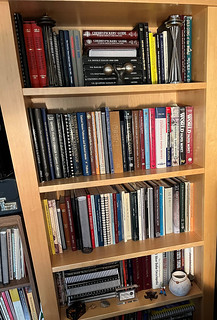 Researching any numismatic topic in the 21st century will mostly likely involve a substantial amount of time spent online. A large percentage of my research time is online. Put a keyword in the search engine and away you go.
Researching any numismatic topic in the 21st century will mostly likely involve a substantial amount of time spent online. A large percentage of my research time is online. Put a keyword in the search engine and away you go.
While the information I am able to locate online is truly phenomenal, I still prefer holding a meaningful numismatic reference book in-hand. Admittedly I might be somewhat of a dinosaur, but my numismatic library is quite special to me.
When I started collecting in the early ‘70s finding any information about coins was difficult. The local library might have a couple of well-thumbed copies of The Red Book
(A Guide Book of United States Coins). Usually these were out of date as well as often missing pertinent pages.
Coin literature wasn't available in any great quantities. Even well-stocked coin shops were limited in the literature they offered because so little was actually available. The weekly coin magazines were great for market news and new coin issues. But, if you wanted to do any in-depth coin research or had harder coin questions, few reference books were available.
Ultimately my numismatic reference library was built one book or catalog at a time. Similar to building a challenging set of U.S. coins, finding some of the books I desired wasn't an easy task. Regardless of whether you are finding missing dates for your set or searching for that elusive out-of-print coin reference book the best collections require diligence.
To read the complete article, see:
Building a Numismatic Library
(https://www.pcgs.com/news/building-a-numismatic-library)
"Revenge payments in coins" are a recurring topic in the news. I don't know if the perpetrators think they're being original but it's always amusing to see play out. Thanks to David Pickup for passing this one along. -Editor
A Chinese company ordered to pay 10,000 yuan (US$1,400) compensation to a worker it illegally sacked has been fined again for paying the amount in loose change, the Southern Metropolis Daily reported on Monday.
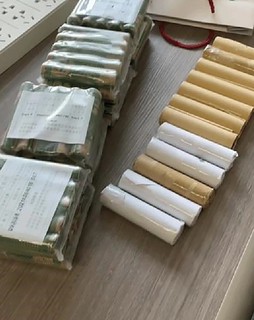 The employer, an unnamed health and wellness provider in Hunan province, southern China, paid the money earlier this month with coins it deliberately changed from banknotes in larger denominations, which weighed over 60kg, the report said, citing a decision from the Kaifu District People's Court.
The employer, an unnamed health and wellness provider in Hunan province, southern China, paid the money earlier this month with coins it deliberately changed from banknotes in larger denominations, which weighed over 60kg, the report said, citing a decision from the Kaifu District People's Court.
The former employee, with the help of a court official, had to count the coins one by one before the court could record the payment on September 14.
As a result the court imposed an additional fine of 5,000 yuan on the company for trampling on the dignity of workers
and wasting the resources of law enforcement
.
David adds:
"Interesting story about paying in coins as a protest. In the UK pennies and two pence coins are legal tender in amounts up to 20 pence."
To read the complete article, see:
‘Trampling on dignity': Chinese boss pays US$1,400 staff compensation in coins then fined again for being ‘disrespectful'
(https://www.scmp.com/news/people-culture/trending-china/article/3194130/trampling-dignity-chinese-boss-pays-us1400-staff)
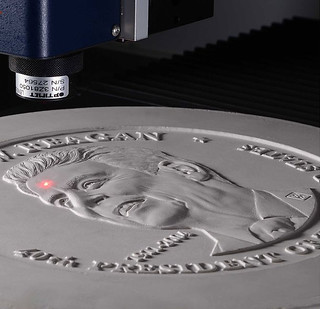 CoinsWeekly profiled the German firm LANG GmbH, a leading supplier of milling and engraving machines to mints around the world. I added an image from their website.
-Editor
CoinsWeekly profiled the German firm LANG GmbH, a leading supplier of milling and engraving machines to mints around the world. I added an image from their website.
-Editor
To visit the LANG website, see:
https://www.lang.de/en/
To read the complete article, see:
50 Years of LANG GmbH: The Leading Supplier of Milling and Engraving Machines
(https://coinsweekly.com/50-years-of-lang-gmbh-the-leading-supplier-of-milling-and-engraving-machines/)
Coin dealer-philosopher Dave Wnuck published a blog post this week on the miracle of coin survival. -Editor
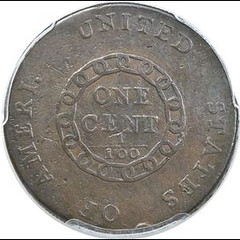 I was reminded of humans' frequent failure to keep nice things in pristine condition when I purchased a collection from a local estate. It was a large collection consisting of very ordinary coins – circulated common date Morgan dollars, dateless Buffalo nickels, oodles of wheat cents and so on.
I was reminded of humans' frequent failure to keep nice things in pristine condition when I purchased a collection from a local estate. It was a large collection consisting of very ordinary coins – circulated common date Morgan dollars, dateless Buffalo nickels, oodles of wheat cents and so on.
But in the midst of this there was a Morgan dollar. A beautiful, unmarred, superb uncirculated 1885 Morgan dollar. It seemed to glow in the dark, especially in that morass of stuff
. How did it remain in this condition for all these years? And how did it end up in there? Seeing it in the midst of that typical, beat up coinage reminded me that every single high grade coin still in existence is a little round miracle.
These objects were made to be used, and used hard. When we see one that has somehow escaped the fate of nearly all of their brethren it gives me a renewed appreciation for each of them.
To read the complete article, see:
Well Preserved Coins are Little Miracles
(https://davewcoins.com/well-preserved-coins-are-little-miracles-plus-new-purchases/)
This week Scott Galloway opened an article about online identity with an interesting case of "death by banknote." -Editor
In 1791 an obscure baroness and her daughters left Paris in a carriage headed west. Along the way, at Sainte-Menehould, their male servant went to change horses, and the town's postmaster, Jean-Baptiste Drouet, thought he looked familiar. Drouet took out a banknote and confirmed, from the face printed on the back, the servant's identity: King Louis XVI, who was supposed to be confined to his palace under revolutionary guard. Within hours, the "servant" was detained at Varennes. It was a costly ID: Two years later, an executioner would hold up the King's recognizable head.
Can anyone provide an image of one of those banknotes? -Editor
To read the complete article, see:
ID
(https://www.profgalloway.com/id/)
BOOK NOOK: OCTOBER 2, 2022
There were several items in the media this week relating to books, so I thought I'd group them together here for our bibliophiles. -Editor
In the now-THAT'S-a-slabbed-collectible department, here's an article about the University of Chicago's attempt to study what is purported to be a 26-page booklet encased in concrete. -Editor
Art historians enlisted the help of Argonne National Laboratory to study artist Wolf Vostell's Betonbuch (Concrete Book).
THE SLAB OF CONCRETE IS more than a foot tall, ten inches wide, and two inches thick. It weighs about 20 pounds, and it is cataloged in the University of Chicago's library system as a book.
This unusual tome, titled Betonbuch (Concrete Book), was published
in Zurich, Switzerland, in 1971 by experimental artist Wolf Vostell. It is one of 100 copies he created by, Vostell explained at the time, encasing a 26-page booklet in concrete. Such concretifications,
as he termed them, were the artist's signature works through the late 1960s and early 1970s, nods to postwar urbanism and challenges to the traditional understanding of what materials are necessary to make art.
The University of Chicago has long owned one of Vostell's best known concretifications, Concrete Traffic. It is, unmistakably, a car covered in concrete—specifically, a Cadillac deVille drowned in a quickly hardening sand-and-stone slurry in a busy commuter parking lot in Chicago one morning in 1970. But when the university acquired copy number 83 of Vostell's Betonbuch in 2016, Patti Gibbons, head of collections management for the Hanna Holborn Gray Special Collections Research Center, began to wonder: Was this a prank, or is this for real?
To read the complete article, see:
Can Science Solve the Mystery of the Concrete Book?
(https://www.atlasobscura.com/articles/vostell-concrete-book-mystery)
Here's a story about Ashurbanipal's Great Library, the oldest surviving royal library in the world. -Editor
Ashurbanipal's Great Library is the oldest surviving royal library in the world. The library consisted of a collection of clay tablets made, covered in fine writing and pressed together on both sides. Up to 30,000 tablets and fragments containing texts of all kinds from the 7th century BC, including texts in various languages, were collected, found under the rubble of the royal palace at Nineveh. One of the most famous works in the library is the Epic of Gilgamesh, considered to be the oldest narrative work of mankind.
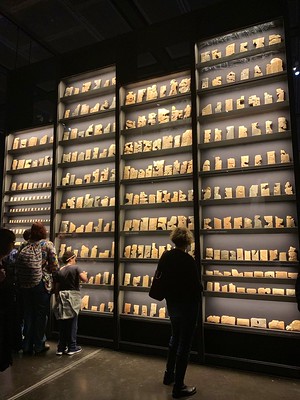 Overshadowed by the powerful empires of Egypt, Greece and Rome that came years later to dominate the world, Assyria has always remained in the background in history. Although much has been written about the leader who established this civilization, few know Ashurbanipal, the ruthless king of the Assyrians.
Overshadowed by the powerful empires of Egypt, Greece and Rome that came years later to dominate the world, Assyria has always remained in the background in history. Although much has been written about the leader who established this civilization, few know Ashurbanipal, the ruthless king of the Assyrians.
Ashurbanipal ruled with an iron fist, but never engaged in battle. Hence, many historians catalog him as a "sociopathic bookworm" who pulled the strings from the capital of the empire, in Nineveh (which gives its name to a current city located in Iraq). From this city he showed his cruelty without having to lead his troops in the fights himself. He preferred to be an opulent leader. In several of the reliefs that formed part of the walls of the palace of this monarch, he is shown hunting lions to show that no beast could conquer him.
But his scholarship crossed borders and Ashurbanipal collected thousands of works written on sheets of clay. Much of the library (in which he preferred to remain secluded) that he assembled is a perfect example of the level of knowledge of the Assyrian empire, the value of education to his kingdom, and the power he wielded during that period of time. All combined made Assyria a region that, according to experts, was "magnificent, innovative and interesting." Ashurbanipal was a complex and often misrepresented figure.
To read the complete article, see:
KNOWLEDGE AS POWER: KING ASHURBANIPAL FORMED THE WORLD'S EARLIEST SYSTEMATICALLY COLLECTED LIBRARY
(https://www.thearchaeologist.org/blog/knowledge-as-power-king-ashurbanipal-formed-the-worlds-earliest-systematically-collected-library)
This article links to videos with more information on each of the titles. Some familiar names here like the Gutenberg Bible and The Codex Leicester, plus a few that may be surprises. -Editor
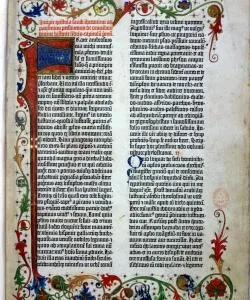 Today, it's easy to find a copy of just about any book. You simply go to your local library or bookstore or order the book online. The books we mentioned below are not so easy to find.
Today, it's easy to find a copy of just about any book. You simply go to your local library or bookstore or order the book online. The books we mentioned below are not so easy to find.
These are ten of the rarest books in history. They are rare because the author decided to print a smaller number of copies, copies got lost to history, etc. In any case, all of the books on our list today have two things in common: They are historically or culturally significant and extremely hard to find.
To read the complete article, see:
10 of the Rarest Books in History
(https://listverse.com/2022/09/29/10-of-the-rarest-books-in-history/)
Speaking of the Gutenberg Bible, The Writer's Almanac for Friday, September 30 noted the anniversary of its first finished section. -Editor
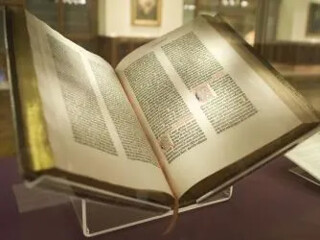 On this day in 1452, the first section of the Gutenberg Bible was finished in Mainz, Germany, by the printer Johannes Gutenberg. Little is known of Gutenberg's early history or his personal life except that he was born around the year 1400, the youngest son of a wealthy merchant, but from the time of the appearance of his beautiful Bibles he has left an indelible mark on human culture.
On this day in 1452, the first section of the Gutenberg Bible was finished in Mainz, Germany, by the printer Johannes Gutenberg. Little is known of Gutenberg's early history or his personal life except that he was born around the year 1400, the youngest son of a wealthy merchant, but from the time of the appearance of his beautiful Bibles he has left an indelible mark on human culture.
Ancient books had primarily been written on scrolls, though an innovation in the second century A.D. — that of the codex, a sheaf of pages bound at one edge — gave us the familiar book form we recognize today. Early codices were produced by hand by monks in scriptoriums, working with pen and ink, copying manuscripts one page at a time so that even a small book would take months to complete and a book the size of the Bible, rich with color and illuminations, would take years.
Gutenberg's genius was to separate each element of the beautiful, calligraphic blackletter script commonly used by the scribes into its most basic components — lower case and capital letters, punctuation, and the connected ligatures that were standard in Medieval calligraphy — nearly 300 different shapes that were then each cast in quantity and assembled to form words, lines, and full pages of text.
He also invented a printing press to use his type, researching and refining his equipment and processes over the course of several years.
Only four dozen Gutenberg Bibles remain, and of these only 21 are complete, but what Gutenberg created went far beyond the reach of those volumes. By beginning the European printing revolution, he forever changed how knowledge was spread, democratized learning, and allowed for thoughts and ideas to be widely disseminated throughout the known world. In his time, Gutenberg's contemporaries called this "the art of multiplying books," and it was a major catalyst for the Renaissance, the Scientific Revolution, and even the Protestant Reformation. In 1997, Time magazine named Johannes Gutenberg "Man of the Millennium" and dubbed his movable type as the most important invention of a thousand years.
To read the complete article, see:
TWA for Friday, September 30, 2011
(https://thewritersalmanac.substack.com/p/twa-for-friday-september-30-2011)
To paraphrase an old rock song, "Out there is knowledge waiting to be had - if you think I'll let it go, you're mad - you've got another thing coming." -Editor
In one of my favorite scenes from the movie Seven, Morgan Freeman's character gets a guard to let him into a library late at night so he can conduct research. While the five members of the library's night staff are sitting around a desk playing cards he says to them:
Gentlemen, gentlemen… I'll never understand. All these books, a world of knowledge at your fingertips. What do you do? You play poker all night.
This scene might serve as a fitting summary of our current culture. At least, that's the implication in a recent Baffler article titled The Death of the Autodidact.
So we are confronted with the situation of a rise in the potential for self-education (in the form of increased access to books, internet resources, MOOCs, etc.) with a decline in autodidacts. Why is that?
In school, students are not rewarded based on how deeply they have assimilated knowledge, and how much this knowledge has improved their character. Rather, they are rewarded for how well they have played the game and jumped through the hoops—they are rewarded based on how high their GPAs are, how many AP classes they have taken, and how many extracurricular activities they have accumulated.
With very few exceptions, your ticket onto a successful career path is not your demonstrated knowledge, ability, and potential; it's how high of a college degree you have, and even more importantly, where you got that degree.
To read the complete article, see:
Without Self-Education, the West Will Probably Die
(https://intellectualtakeout.org/2016/10/without-self-education-the-west-will-probably-die/)
Books about booksellers and collectors are a classic subgenre. A new one is coming from a young author at Henry Sotheran in London. Maybe not all youth is indifferent to knowledge. -Editor
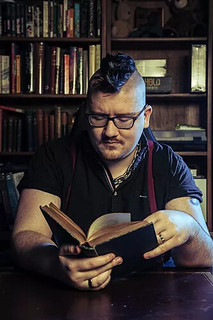 A book revealing what it is really like working at a rare book shop is being published. Once Upon a Tome The Misadventures of a Rare Bookseller has been written by Oliver Darkshire, 28, who works at Henry Sotheran on Sackville Street in Mayfair.
A book revealing what it is really like working at a rare book shop is being published. Once Upon a Tome The Misadventures of a Rare Bookseller has been written by Oliver Darkshire, 28, who works at Henry Sotheran on Sackville Street in Mayfair.
Darkshire runs the firm's Twitter account (@Sotherans) which has attracted more than 41,000 followers largely because of his very entertaining tweets
. The book, published by Bantam Penguin Random House, launches on October 6.
To read the complete article, see:
A new art dealer, auction house and a book – updates from across the world of art and antiques
(https://www.antiquestradegazette.com/news/2022/a-new-art-dealer-auction-house-and-a-book-updates-from-across-the-world-of-art-and-antiques/)
This article is from 2020, recommending books with themes related to famous Twilight Zone episodes. -Editor
Here, weary traveler, you find yourself with your back to the closed door of the Twilight Zone. In front of you now there are thirteen doors with unknown horrors and unsolved mysteries that await. It is, like the land you have come from, a realm of shadow and substance both, fueled by imagination. You have entered a world where people will come alive from the page, where their stories will trod behind you for the rest of your days.
To read the complete article, see:
Here is the book you should read based on your favorite episode of The Twilight Zone.
(https://lithub.com/here-is-the-book-you-should-read-based-on-your-favorite-episode-of-the-twilight-zone/)
Another Writer's Almanac for September 28th discusses the real and fictional bookseller Nicholas Flamel. -Editor
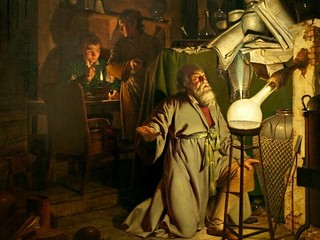 Today is the birthday of scrivener and alchemist Nicholas Flamel, who was born on the outskirts of Paris in the year 1300 to a poor but respectable family. He was given a good education, and when he was an adult set up shop in the Rue de Marivaux, copying texts, writing letters, selling manuscripts, and apparently sometimes writing his own original poetry.
Today is the birthday of scrivener and alchemist Nicholas Flamel, who was born on the outskirts of Paris in the year 1300 to a poor but respectable family. He was given a good education, and when he was an adult set up shop in the Rue de Marivaux, copying texts, writing letters, selling manuscripts, and apparently sometimes writing his own original poetry.
Flamel is said to have come into possession of curious book, which he bought for two florins from a stranger who'd come to his bookstall in need of money and with a manuscript to sell. The book was bound in worked copper, engraved with curious symbols and characters, its 21 leaves made of the bark of young trees and inscribed with a sharp metal point, and even a seventh leaf illuminated with the picture of a serpent, or serpents: swallowing swords, crucified on a cross, and trailing from a bubbling fountain in the middle of a treeless desert. This was the Book of Abraham the Jew, and it contained a complete exposition on the art of transmuting base metal to gold, using the legendary philosopher's stone, and the means by which one could distill from the stone the Elixir of Life and extend human life indefinitely.
A new generation has been introduced to Nicholas and Perenelle Flamel, who were close friends of Albus Dumbledore, wizard and headmaster of Hogwarts School of Witchcraft and Wizardry, where Harry Potter and his friends attended school. In the first book of the series, The Sorcerer's Stone, the Flamels were in their upper 600s, living in Devon and kept immortal by regular infusions of the Elixir of Life, but were forced to destroy their philosopher's stone to keep it from the clutches of the dark wizard Voldemort and so, finally, passed away.
To read the complete article, see:
WEDNESDAY Sep. 28, 2011
(https://writersalmanac.publicradio.org/index.php%3Fdate=2011%252F09%252F28.html)
For more on Flamel and the Philosopher's Stone, see:
Traces of the Alchemist Who Discovered the Philosopher's Stone in Paris
(https://www.atlasobscura.com/articles/nicolas-flamel-and-the-philosopher-s-stone)
SNEAKER AUTHENTICATORS
You thought third-party authenticators were done after they came for your comic books? Get ready for sneaker authenticators. Gerry Tebben passed along this article with the email subject line, "Sneakers authenticators for God's sake." -Editor
Gerry writes:
"While it doesn't have anything to do with coins, E-Sylum readers might find this article in yesterday's Washington Post interesting. Sneaker Authenticators! I wear my sneakers to authentically walk the dog."
Justin Mupas holds up two identical-looking pairs of the Nike Chunky Dunkys," a highly sought-after sneaker that can resell for more than $1,000.
Do you think you can pick which one is real and which one is fake?" he asks.
The real Chunky Dunky pair, a 2020 collaboration with ice cream maker Ben & Jerry's that originally sold for $100, features Nike's signature swoosh in yellow and a cow skin pattern, an homage to the bovine face of the ice cream maker's packaging.
But for Mupas, who examines hundreds of shoes each day as a trained sneaker authenticator for the online marketplace StockX, the smell is a giveaway: real Chunky Dunkys give off the scent of animal fur. The fakes smell like factory glue.
Resale companies including eBay, StockX and GOAT have turned to sneaker authenticators to protect their trade, promising patrons that sneakers resold on their sites are certified.
While authentication videos have circulated around YouTube, TikTok and Instagram, some of the microscopic tells of authentic footwear are kept covert, hidden in the depths of companies' authentication centers around the world. It's the key to edging out competitors — and to combat counterfeits.
That's another reason why we don't really tell people what every aspect of our test is,
said Garry Thaniel, eBay's general manager of sneakers. Just because people will plan for those things.
Authentication is a form of security" for the sneaker resale market — just as similar security and verification processes are for art, handbags, jewelry and technology, said Kevin Rivera, a designer and adjunct professor of footwear design at the Fashion Institute of Technology.
While human authenticators are a public face of the work, technology also plays a part.
Entrupy, a company that focuses on AI-based authentication, created an app that uses machine learning algorithms to verify items. Last year, Nike partnered with Customs and Border Protection to give the agency technology for the authentication of its merchandise at certain facilities, though neither organization said what the tool was.
Gerry adds:
"I like that sneakers have to pass an actual smell test."
To read the complete article, see:
As counterfeits rise, sneaker authenticators sniff out real from fake
(https://www.washingtonpost.com/business/2022/09/30/sneaker-authentication-ebay-stockx-nike/)
COLLECTING BARF BAGS
The Washington Post gets around the collectibles world. John Isles of Hanover, Michigan submitted this piece about collectors of... airplane barf bags. -Editor
Steve Silberberg was flying from Boston to San Francisco as a college student in 1982 when he took note of the small bag in front of him.
I bet no one collects these, he thought.
So he swiped the bag — United, light blue, instructions helpfully written on the surface — and put it on his door. Friends started offering bags from their own travels. Thus, the collection that became the Air Sickness Bag Virtual Museum, now numbering more than 3,200 specimens, was born.
One can tell a lot about an airline's image from their Air Sickness Bags,
Silberberg, 61, writes on one of the two sites dedicated to his hobby. Some barf bags are no more than a baggie with a twist tie, while other sickbags could win international design competitions. Are they art? I think so.
He's not the only one. Contrary to his thought four decades ago, other collectors around the world share his offbeat enthusiasm, posting their own prized possessions online, trading for new finds and even connecting in person at airline memorabilia events during pre-pandemic times.
But the global community of baggists,
as some call themselves, is small and not growing — in part due to an aging cohort and because fans say bags just aren't that great anymore. Instead of the branded or whimsically designed ones from the past, many airlines are providing plain white options.
I think it's shrinking a bit because of a lack of new bags,
said Bruce Kelly, 79, a retired corrections worker in Anchorage whose maintains Kelly's World of Airsickness Bags online. His collection tops 7,300, which many of the world's top enthusiasts have dropped by to see.
Kelly said he believes there were somewhere in the neighborhood of 100 baggists at one point. He's not sure how many are active now.
Paul Mundy, a Germany-based communications specialist who works in international relations, has nearly 2,500 bags in a collection that started by necessity. (Have you flown with the toddler?
he asked a reporter with a 2-year-old. Try it. And you will become interested in airsickness bags, too.
) But he only grabs a new bag on the rare occasions that he flies and hasn't updated his site, Bagophily.com, for several years.
The virtual museum has earned Silberberg a small measure of fame; he is even featured in this year's Dull Men's Club Calendar for July. But he'd really love to bring the museum to a brick-and-mortar existence.
John adds:
"I'm betting I won't be the only person suggesting you use this story in The E-Sylum. Collectomania is still a thing!"
Well, you're the first to submit this story, but (unsurprisingly) we've covered the topic once before. Kudos to the Post for the great image.
I think Collectomania will always be a thing. There's something about humankind that requires a certain subset of the population to be collectors and students of just about anything. Don't judge us - we were born this way. -Editor
To read the complete article, see:
Meet the people collecting airplane barf bags
(https://www.washingtonpost.com/travel/2022/10/01/airplane-barf-bag-museum/)
To read the earlier E-Sylum article, see:
WEIRD THINGS PEOPLE COLLECT
(https://www.coinbooks.org/v23/esylum_v23n23a40.html)
FEATURED WEBSITE: CENTRAL STATES NUMISMATIC SOCIETY
This week's Featured Web Site is the new address for the Central States Numismatic Society.
The Central States Numismatic Society, founded in 1939, is one of the larger numismatic organizations in the United States with membership fluctuating around 2,000. CSNS, as it is known informally, operates in a 13 state Midwestern region but membership is open to residents of all states and foreign countries.
States in the region are Illinois, Indiana, Iowa, Kansas, Kentucky, Michigan, Minnesota, Missouri, Nebraska, North Dakota, Ohio, South Dakota and Wisconsin.
https://www.csns.org/

